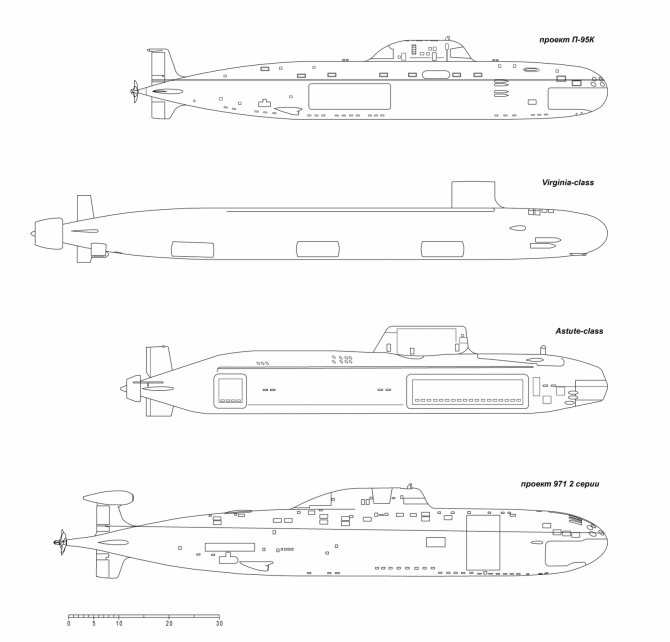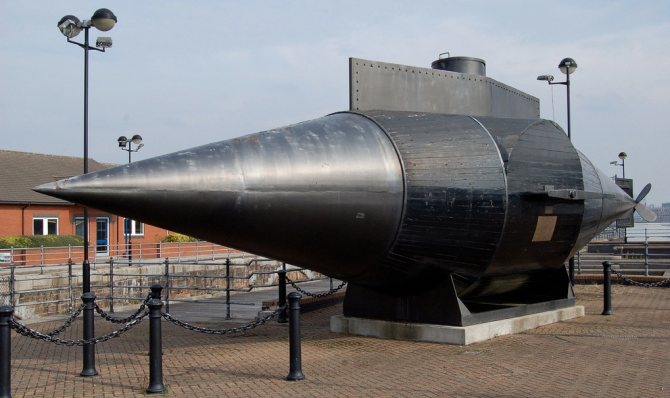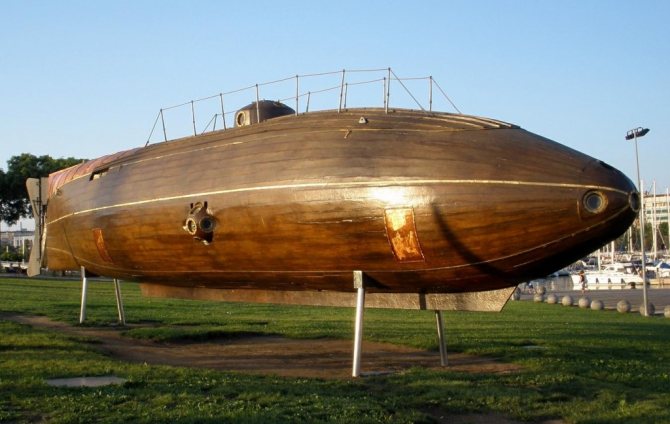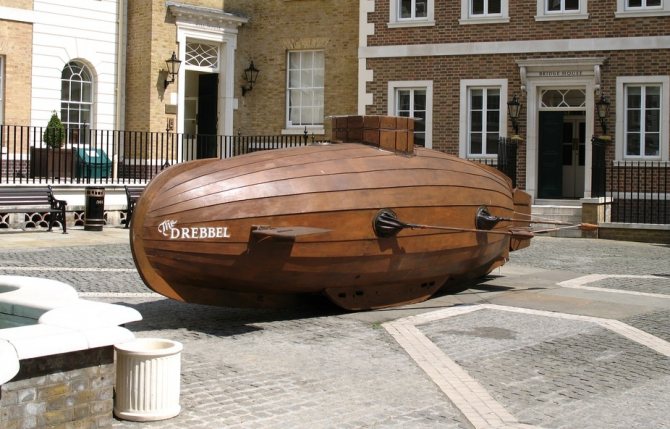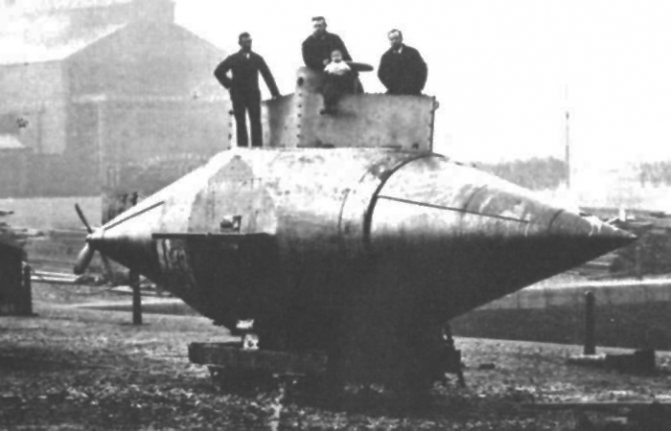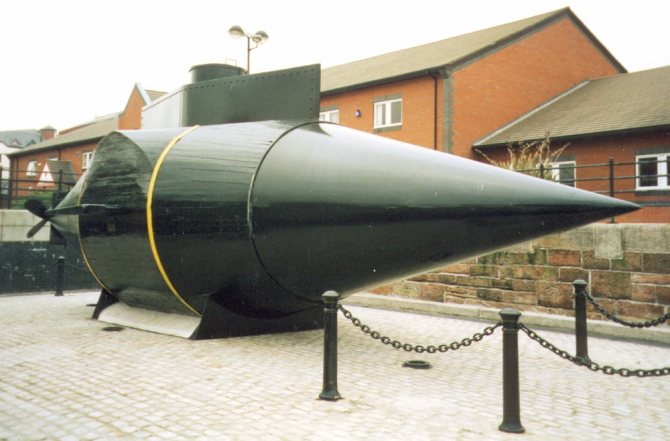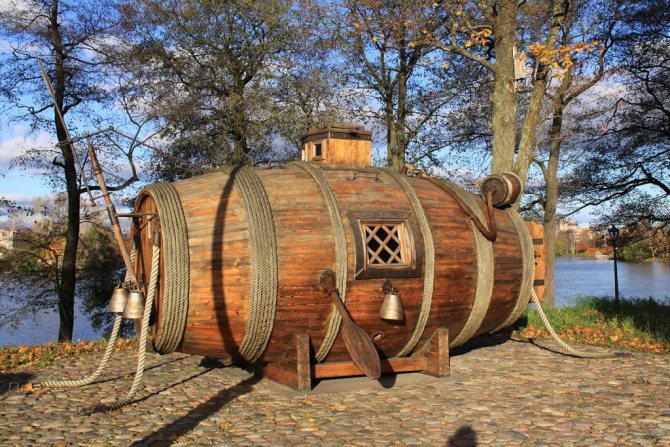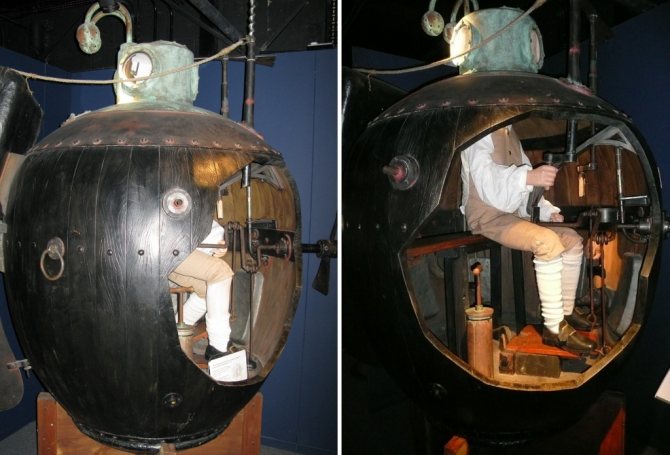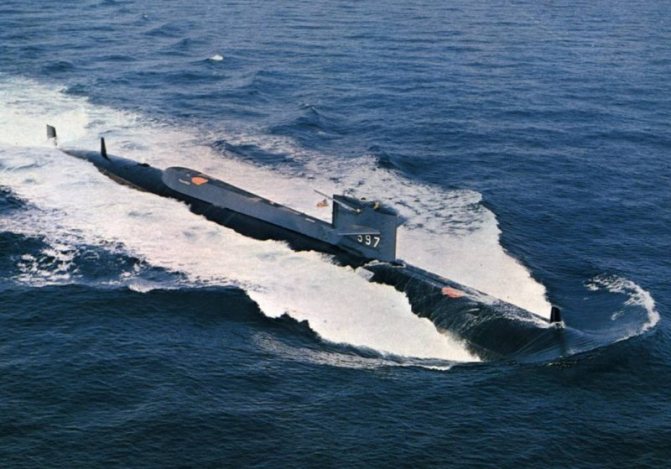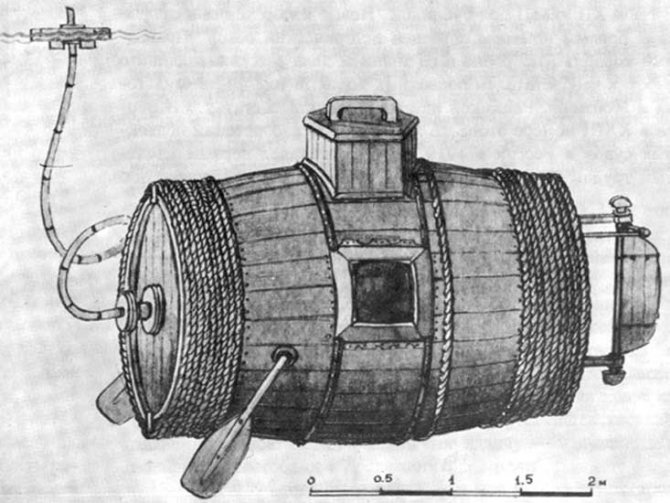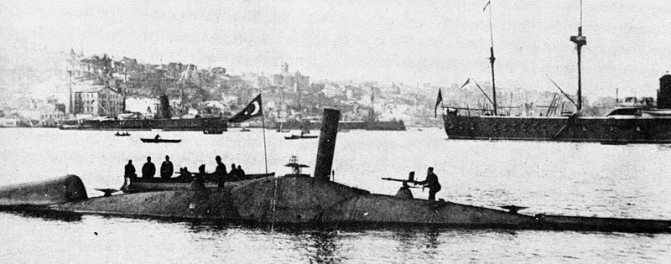In places where there is no access to the central heating system, electric boilers are often used. They work on the principle of converting electrical energy into heat using a heat carrier (water or antifreeze) moving through the pipeline system. One of the types of electrical equipment is ionic heating boilers. Let's consider everything in more detail.
Initially, all electric boilers, according to the method of connecting to the network, are divided into: single-phase (220V) and three-phase (380V). They can also be single-circuit (capable of providing only room heating) and double-circuit (with the ability to additionally heat water for domestic use).
By manufacturing technology, they are divided into three types:
- Electric boilers with heating element (heating element)
- Induction boilers
- Electrode (ion) boilers
History of appearance and principle of operation
During just 1 second, each of the electrodes collides with the others up to 50 times, changing their sign. Due to the action of alternating current, the liquid does not divide into oxygen and hydrogen, retaining its structure. An increase in temperature leads to an increase in pressure, which forces the coolant to circulate.
To achieve the maximum efficiency of the electrode boiler, you will have to constantly monitor the ohmic resistance of the liquid. At a classic room temperature (20-25 degrees), it should not exceed 3 thousand ohms.
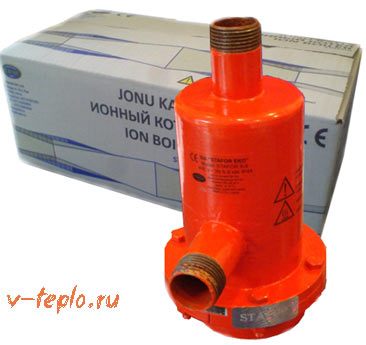
Distilled water must not be poured into the heating system. It does not contain any salts in the form of impurities, which means that you should not expect it to be heated in this way - there will be no medium between the electrodes for the formation of an electrical circuit.
For additional instructions on how to make an electrode boiler yourself, read here
"Sunk by the latrine": Shame on the German submarine fleet?
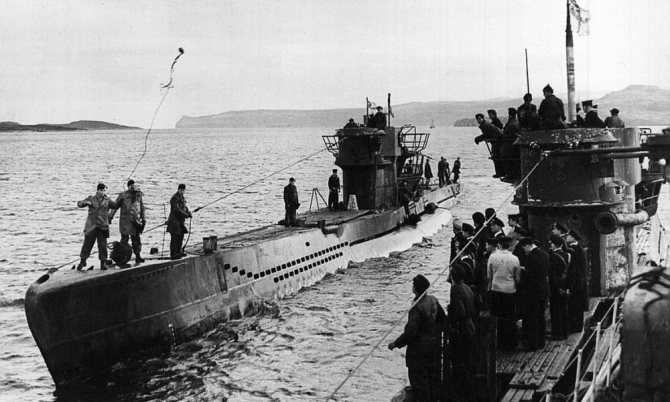

Where are you going from the submarine!
Have you ever thought about the fidelity of this phrase? Huge water pressure, depth from which it is stupid not to rise without decompression sickness, heavy-duty hull and all things. You can't go anywhere. But if you need it urgently? How can anything ever leave submarine? Torpedo tubes are a joke, of course, a good one, even for evacuation they can be used in some cases. But what if we are talking about, sorry, about shit? You can, of course, carry it with you, as, for example, airliners do. But the plane flies for a day at most, and submarines may not pop up for months. Moreover, if the waste is stupidly dumped overboard, it will unmask the submarine. Seriously, there have been a couple of similar cases in military history. So the engineers had to come up with an ingenious design. latrine, to solve this problem. But only once it was this design that caused the death of a combat submarine.
Version 1
1944 year. North Sea. Submarine U1206 embarks on its first combat mission under the leadership of Lieutenant Commander Karl-Adolf Schlitt. The task is to flood another British convoy. It's simple, they sailed, flooded, a lesson for several days, well, a couple of weeks maximum. But no.
The convoy was found quite quickly, but when entering the attacking positions, it became clear that the diesel engine was not working efficiently enough and the submarine could not develop the required speed. It was decided to go to the bottom, repair the diesel engine and continue to act according to the situation. In principle, everything is logical. The situation is freelance, but controlled.
And the commander trite itch to go to the toilet. It happens to everyone, especially since the construction of latrines on submarines designed to function at the bottom. To simplify, first you turn one valve - it flushes the shit into the storage tank. Then you close the first one and turn the second one - it turns on the rinsing of the container under pressure with seawater. There are still some tricks against surfacing, but there is no need to go into these details. Everything seems to be simple. Just in case, there is a manual on the door, and one of the service engineers knows in detail how this system works.
The captain does his business, turns the valve - there is no effect. Spins further - there is no effect. Calls for help - it is useless to leave the latrine dirty. The sailor who came to the rescue turns the valve. Second. When the first one is not closed. A pillar of water from the toilet, under pressure of 80 meters of water. All washes away, it is impossible to get to the valve, because the flow. The command for an emergency ascent, surface, only the water seeps through the bulkheads and reaches the battery compartment. Chlorine vapors begin to fall, boat raised for airing. But there are already victims. And this is where the convoy appears. Of course, no one understands what the Fritzes have there, they immediately attack. The boat gets damaged, but manages to leave, however, then the crew is still forced to urgently leave the submarine. This is how a simple unclosed latrine valve destroyed the mighty creation of German military engineers.
Version 2
To begin with, let's think for a second about who made this story widely known. Jochen Brennecke, the author of various books about the German submarine fleet, including Hunters - Victims, where this story was first mentioned, worked under the leadership of a certain Goebbels. And he was engaged in just the propaganda of the heroic image of the Kriegsmarine to the masses. But why would he publish a book in which an exemplary German officer is the main cause of death? submarine, and solely due to non-observance of instructions? And then, according to rumors, Herr Schlitt had long wanted to surrender to the Allies, and not continue to heroically carry out orders. So to dishonor a defeatist is a sacred cause for a propagandist.
On the other hand, facts remain facts. Yes, there were problems with the diesel. Yes, there was flooding of the compartments due to a problem with the seacock at the latrine - this is all in the official documents. Moreover, in the same documents it is attested that the technical equipment submarines in the last years of the war it was, to put it mildly, bad. Who cares - read the memoirs of a certain Peter Kremer, an underwater ass from the Kriegsmarine. And if the diesel generator is out of order, then why couldn't the same thing happen to the valve in atypical operating conditions? By the way about. The submarine was found and investigated. Someone Innes McCartney, an underwater archaeologist. And he confirmed the official data regarding its flooding.
Seriously, let's look at the facts. Submarine enlisted in the 11th flotilla in February. At the end of March, she left the city of Kiel, and on April 6 she set out on the first campaign. Problems started from 13 to 14, that is, in less than a month of operation. In conditions, recall, full immersion to a depth of 80 meters.
In favor of the fact that Brenneke's version is false, there are also some discrepancies with its real picture, recorded in the reports. For example, in reality, the pop-up submarine no one bombed, and the officers had enough time to pick up the documentation and discharge the torpedoes. And no one was officially killed by chlorine - 3 victims of this incident simply drowned while trying to get to the shore.
So, dear readers, think about which version you like best. The version of the commander who made a mistake, or the version that blames everything on the really bad equipment of the German submarine fleet in recent years. But, you must admit, it is more pleasant to think that it is "the damned fascists screwed up, uuuu!"
Features: advantages and disadvantages
The ionic type electrode boiler is characterized not only by all the advantages of electric heating equipment, but also by its own characteristics. In an extensive list, the most significant ones can be distinguished:
- The efficiency of installations tends to the absolute maximum - not less than 95%
- No pollutants or ionic radiation harmful to humans are released into the environment
- High power in a body relatively small in size compared to other boilers
- It is possible to install several units at once to increase productivity, a separate installation of an ion-type boiler as an additional or backup heat source
- Small inertness makes it possible to quickly respond to changes in ambient temperature and fully automate the heating process through programmable automation
- No need for a chimney
- The equipment is not harmed by the insufficient amount of coolant inside the working tank
- Voltage surges do not affect heating performance and stability
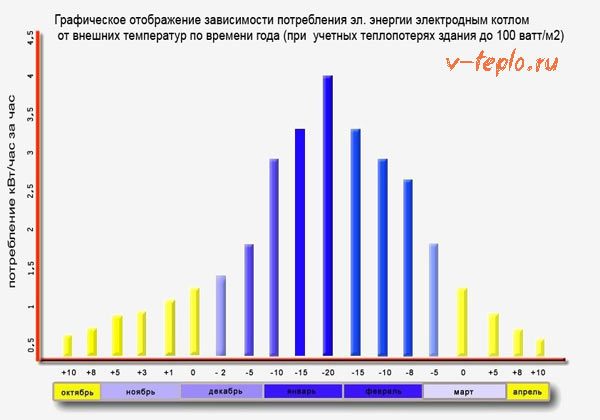

You can find out how to choose an electric boiler for heating here
Of course, ion boilers have numerous and very significant advantages. If you do not take into account the negative aspects that arise more often during the operation of the equipment, all benefits are lost.
Among the negative aspects, it is worth noting:
- For the operation of ionic heating equipment, do not use direct current power sources that will cause electrolysis of the liquid
- It is necessary to constantly monitor the electrical conductivity of the liquid and take measures to regulate it
- You need to take care of reliable grounding. If it breaks down, the risks of being electrocuted increase significantly.
- It is prohibited to use heated water in a single-circuit system for other needs.
- It is very difficult to organize effective heating with natural circulation, the installation of a pump is required
- The temperature of the liquid should not exceed 75 degrees, otherwise the consumption of electrical energy will sharply increase
- Electrodes wear out quickly and need to be replaced every 2-4 years
- It is impossible to carry out repair and commissioning work without the involvement of an experienced master
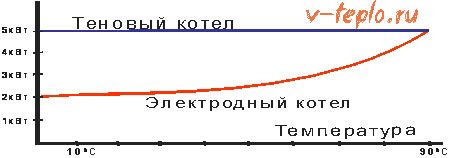

Read about other methods of electric heating at home here.
Ventportal
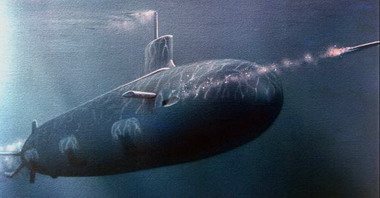

Air conditioning issues in residential and public buildings with stringent indoor microclimate requirements are often challenging for professionals. It is always interesting to consider the limiting case of using air conditioning units, one of the manifestations of which is the lack of the possibility of using outside air. This limiting case allows a specialist to move away from the usual traditional views, approaches and makes it possible to come to new technical solutions.
Modern submarines, such as, for example, the submarine Seawolf (SSN -21) ("Sea Wolf"), which is part of the US Navy, are the concentration of the most modern developments, including air conditioning systems. Such vessels are usually operated submerged, but, if necessary, they function as normal surface ships.
For reference:
IN THE SUM of characteristics, the best submarine of the outgoing century should be recognized as the American nuclear submarine of the fourth generation "Seawolf" ("Sea Wolf"), which entered service in 1998. the world, since it cost taxpayers almost $ 3 billion.
a source Encyclopedia of ships / Multipurpose submarines / Sifulv
Since a modern submarine in an ordinary submerged state cannot renew its internal air with fresh atmospheric air, an artificial environment must be created on it.Since a boat can be under water for a long time, one of the most pressing problems for people on board a submarine is creating a comfortable and healthy living environment. These are the tasks set before the designers of shipboard HVAC systems and refrigeration systems.
How can these problems be solved? What equipment is designed to create and maintain an artificial environment in which a team of more than 100 people must stay for a long time? How do you control this environment? And how does this equipment and related methods differ from the equipment and methods of solving similar problems in modern water-conditioned buildings on the shore?
To answer these questions, this article discusses equipment, technologies and methods for creating an artificial environment on submarines.
Air conditioning system design
Nuclear installations used on modern submarines represent an almost unlimited source of energy. In addition, the boats are equipped with batteries and an auxiliary diesel engine that can be used instead of a nuclear installation. When the boat is near the water surface, diesel air can be drawn from the atmosphere. In this case, conditioned air can be supplied for command breathing and for other needs that require fresh air. At the docks or at the berth, shore-based auxiliary equipment is used, with the help of which the internal air of the boat is replaced. The interior of the boat can be ventilated, heated, air conditioned or cooled using equipment specially designed for submarines, similar to those used in modern buildings.
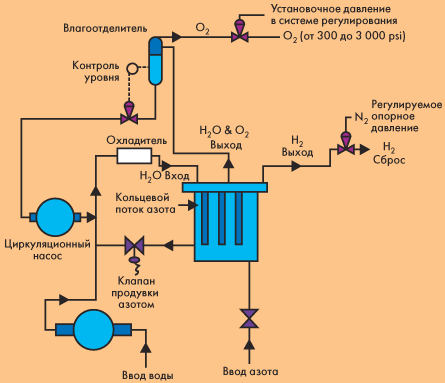

Fig. 1. Oxygen plant.
However, when the vessel is underwater, the internal atmosphere must be maintained for a sufficiently long time, during which the boat must be submerged in order not to be detected. Now imagine the difficulty of performing this task on a submarine like the Seawolf. It is "clogged" with various materials and equipment for maintaining thermal parameters and removing waste gases. We know that the air in it is highly polluted - 130 people spend months in a cylinder 108 m long and 12 m wide.In addition, in addition to contamination from equipment, HVAC system designers must take into account the garbage generated, lint from linen, contamination generated during cooking. , human body odors, sewage and chemical leaks.
It is difficult to find information in the scientific literature on the heat loads and cold consumption of the Seawolf, however, based on the operating experience of nuclear submarines of this class, some assumptions can be made about the size and type of air conditioning equipment installed on this boat, as well as the possible cold consumption. ... Based on this data, factors such as thermal loads from electronic or electrical equipment, parameters of the main power plant, the size of the team and the size of the enclosure can be considered.
When calculating the heat load, it is important to know whether the electrical equipment is cooled with normal or chilled water. Unforeseen emergency factors such as steam leaks or energy losses must be taken into account. When sizing fans and cooling coils to meet regulatory requirements for temperature and humidity levels, the factors of comfort in the engine room and living quarters must be taken into account. To ensure a healthy living environment in the confined space of a submarine, all internal contaminants must be addressed.
Most likely, the Seawolf submarine is equipped with two ship kits, each of which includes two centrifugal coolers.
When the boat is under way, the typical maximum cold flow is between 528 and 703 kW. Perhaps a boat could get by with one set, but the normal load is split into two sets of coolers. The second ship's kit is likely to serve as a reserve. The primary engines for the coolers are powered by ship service generators. The air handling unit provides temperature controlled air to the various power consumption centers to properly regulate humidity and temperature. Most likely, the heat generated by electrical equipment is used to a large extent.
The internal volume of Seawolf is probably between 9,000 and 11,300 m3. If the cold consumption indicator is 703.4 kW, the specific cold consumption is 0.07 kW / m3.
Equipment used
Since steam and electricity are abundant, heating with hot water is not a problem. In the past, lithium bromide absorption machines and centrifugal coolers were widely used for cooling. Other industrial equipment such as rotary screw compressors, scroll compressors, pumps, fans and electronic filters also deserves the attention of submarine equipment designers. The most important characteristic of this type of equipment is the ability to control temperature and humidity in all rooms and compartments, as well as the ability to maintain the required environmental parameters in isolated compartments in the event of an emergency. This, in turn, determines the need to use a centralized control system in the presence of redundant backup equipment.
Since the submarine must provide air recirculation and maintain adequate indoor air quality, filtration functions and tight control of pollutants are of paramount importance. This requires special equipment that generates oxygen from seawater, separates carbon dioxide from the recirculated air and filters out unwanted gases from it.
At sea level, dry air is composed of approximately 78% nitrogen, 21% oxygen and small amounts of carbon dioxide, ozone and noble gases. The maximum water content is 4% (in the tropics). Submarines maintain a specified percentage of indoor air using the equipment listed below.
Oxygen supply systems
When the boat is submerged, oxygen can be replenished in controlled quantities from sources such as oxygen plants, oxygen supplies, oxygen candles. An oxygen plant is an unlimited source of safe breathing oxygen generated by electrolysis of water using solid polymer electrolyte cells. The catalyst-laden plastic diaphragm serves as an electrolyte and separator. The unit is microprocessor controlled and has a shutdown, flush, restart and full capacity cycle time of about 15 minutes. The oxygen generated by the plant can be fed into the compartments of the boat or collected in the oxygen storage, and the hydrogen produced along the way is removed in a safe manner.
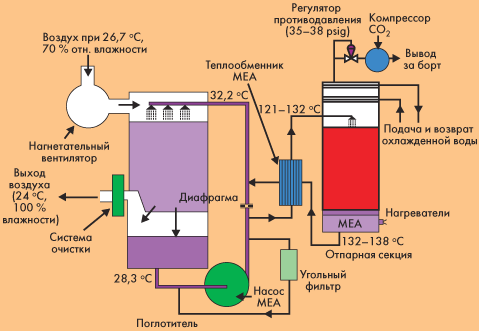

Fig. 2. Installation of CO2 removal
Carbon dioxide (CO2) removal system
In a submerged submarine, carbon dioxide is usually removed by CO2 scrubbers. Lithium oxide containers may also be used in emergencies. Gas scrubbers use a monoethanolamine (MEA) solution to remove CO2.The cleaning process is carried out in the absorber when the air comes into contact with the recirculating MEA, as well as when the released steam and CO2 come into contact with the falling MEA in the stripping section of the boiler. Since monoethanolamine is corrosive and toxic, extreme care must be taken not to enter the air.
Electrostatic deposition apparatus
Electrostatic precipitators are used to remove particles as small as one micron. Ionized plates charge suspended particles, which are then collected on the ground plates. Contaminated plates are periodically cleaned with ultrasound or in cleaning stations. Since electrostatic precipitators are potential sources of ozone due to arcing, electrostatic precipitators must be operated at the correct voltage to prevent arcing, and all required settings must be observed.
Oil mist settling apparatus
Airborne oil mist from the engine oil pan of the turbo generators and from the outlets of the bearing housings is removed by a mist separator. Just like the electrostatic deposition apparatus, this apparatus forms a positive charge on the oil particles of the air supplied to it. The particles then settle on a grounded bushing and drain back into the oil sump.
Pre-filters
Pre-filters are used to prevent large particles (larger than 10 microns) from entering the settling apparatus.
Burner for carbon monoxide and hydrogen (CO-H2)
An essential part of the submarine air purification system is the CO-H2 furnace, which is used to reduce the content of carbon monoxide, hydrogen and hydrocarbon contaminants. In the CO-H 2 furnace, catalytic combustion is used, as a result of which carbon monoxide is converted into carbon dioxide and water. The heated air is passed over a layer of material called hopcalite. If a refrigerant leak occurs on board, the CO2 firebox will react to this leak. However, partial oxidation of hydrocarbons passing over the catalyst rather than through it can lead to the formation of toxic by-products. Chlorinated refrigerants such as R -12 and R -114 form toxic components HF and HCI of acceptable concentration levels, and non-chlorinated refrigerants, such as R -134 a and R -236 fa, form toxic components at a temperature of 316 ° C, although up to a temperature 260 ° C, the level of their concentration can be considered acceptable. In fig. 3 shows a diagram of the air flow through a typical CO2 furnace.
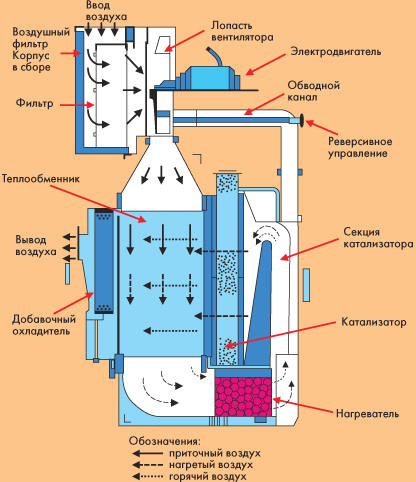

Fig. 3. Burner of carbon monoxide and hydrogen
Lithium Carbonate Filters
For further absorption of decomposition products by acids (HF and HCI), a lithium carbonate filter is located downstream of the CO2 stream. Often the lithium carbonate layer is renewed due to the formation of this substance on the submarine when carbon dioxide passes over the container with LIOH. Commercially available lithium carbonate is not used.
Activated carbon filters
Coconut shell activated carbon is used to remove pollutant gases through capillary attraction and absorption. Absorption is the dominant process for organic components such as hydrocarbons. The limit of the retention power of coal under normal ventilation conditions is the practical saturation limit. Since the absorption process in coal displaces a lower molecular weight gas or steam with a higher molecular weight gas or steam, the main coal bed may lose its ability to remove unwanted lower molecular weight components from the submarine's atmosphere. When it is determined that the carbon has reached saturation, it must be replaced with an available fresh carbon filter.Activated carbon is used in the main ventilation system, in toilet room filters, hygienic ventilation ducts, and in sanitary duct filters.
Ventilation system
On a submarine, the ventilation system also performs the functions of heating and air conditioning. It distributes conditioned air to all compartments of the submarine. Cooled, heated and dehumidified air circulates in the system. The ventilation system removes air from the premises, supplies polluted air to mechanical filters, electrostatic precipitators, filters with activated charcoal, to the CO2 removal system and to the CO-H2 furnaces. It evens out the concentration of atmospheric gases and circulates air with restored parameters. When the submarine is surfaced or semi-submerged, the ventilation system supplies air for the diesel engine, the low pressure supply fan, and for the renewal of breathing air. It ventilates the battery compartment, circulates cold dry air in the missile control and navigation equipment compartments, produces emergency ventilation with exhaust air overboard and reduces the oxygen concentration on the oxygen supply devices, distributing it throughout the submarine.
Control of pollution sources
While the proper equipment is in place, the most effective way to reduce or eliminate toxic contaminants in a submarine's atmosphere is through a well-developed contamination source control program. Such a program should include verification and control of materials, as well as strict adherence to internal regulations. For example, volatile hydrocarbons such as spilled engine oil, hydraulic oil, or diesel leaks must be cleaned up immediately to reduce airborne emissions.
Conclusion
Submarine experience with the equipment described above shows that the concentration of hydrocarbons can be achieved at the level of one or two parts per million. This can be accomplished with proper discipline in housekeeping, control of solvent use, refusal to use oil paints, and strict adherence to painting procedures before starting work in a sealed boat environment. Preventive measures should be applied, including strict supervision and accounting of all materials brought on board, accounting for the time and place of use of materials, control of the amount of materials used.
These are just a few of the tools available to developers and creators of a safe and healthy submarine environment.
The quality of indoor air in a submarine can be monitored using infrared spectrophotometers, mass spectroscopy devices, devices for determining paramagnetic properties, thermal conductivity, photoionization, colorimetric data. The analysis results can be compared with previous data and used to determine appropriate maintenance procedures, such as replacing activated carbon filters. A variety of instruments are used to carry out measurements on board, based on these principles.
The following instruments are used: central monitor for monitoring the atmosphere, analyzer of gas impurities, hydrogen detector, portable device for monitoring atmospheric parameters, portable oxygen analyzer, mine safety indicator, colorimetric analysis tubes, pump testers. These devices can be used both before diving and during boat diving.They can be used during a fire to locate areas that have not been affected by the fire, or to monitor areas where refrigerant is handled.
Currently, there are many types of specialized submarines. Their purpose may not only be to carry out patrols and other special tasks to preserve the world. However, at least some of the equipment described above, or modifications thereof, must be used on board to enable the crew of the submarine to carry out their work in a safe environment. And the use of this equipment will expand as humanity will continue to conduct research and expand the use of the depths of the world's oceans.
Literature
- Foltz D. The design of air conditioning and ventilating systems for nuclear submarines since Nautilus. 1990. (The history of the development of air conditioning systems on submarines is described, starting with the Nautilus, factors influencing the choice of equipment are considered.)
- Smith D., Ung K. Leveraging active submarine force and new attack submarine hazardous material control and minimization programs. (Materials proposed for use in the confined environment of a submarine are described and evaluated: adhesives, paints, solvents, and insulation materials.)
- Weathersby P. K., Lillo R. S. Assumptions in setting air quality standards for naval undersea environments. 1996. (Describes safe exposure levels for many toxic substances.)
- Jones L. B. The tourist submarine industry. (A summary of the development of diving equipment is provided. The list of such equipment includes 48 purpose-built tourist submarines and seven commercial deep-sea vehicles converted to take on board passengers. Each year these submarines and vehicles serve about two million passengers who want to observe the underwater world from the environment air conditioned.)
Translated from English by L.I.Baranov.
Based on materials from j-la "AVOK (ventilation, heating, air conditioning)"
Device and technical characteristics
At first glance, the construction of an ion boiler is complicated, but it is simple and not compulsory. Externally, it is a steel seamless pipe, which is covered with a polyamide electrical insulating layer. Manufacturers have tried to protect people as much as possible from electric shock and expensive energy leaks.
In addition to the tubular body, the electrode boiler contains:
- The working electrode, which is made of special alloys and is held by protected polyamide nuts (in models operating from a 3-phase network, three electrodes are provided at once)
- Coolant inlet and outlet nozzles
- Grounding terminals
- Terminals supplying power to the chassis
- Rubber insulating gaskets
The shape of the outer casing of ionic heating boilers is cylindrical. Most common household models meet the following characteristics:
- Length - up to 60 cm
- Diameter - up to 32 cm
- Weight - about 10-12 kg
- Equipment power - from 2 to 50 kW
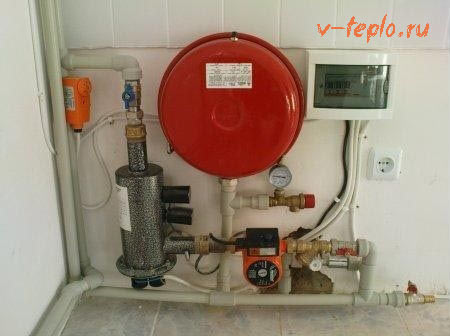

For domestic needs, compact single-phase models with a power of no more than 6 kW are used. There are enough of them to fully provide a cottage with an area of 80-150 square meters with heat. For large industrial areas, 3-phase equipment is used. An installation with a capacity of 50 kW is capable of heating a room up to 1600 sq. M.
However, the electrode boiler works most efficiently in conjunction with the control automation, which includes the following elements:
- Starter block
- Surge protection
- Control controller
Additionally, control GSM modules can be installed for remote activation or deactivation. Low inertness allows quick response to temperature fluctuations in the environment.
Due attention should be paid to the quality and temperature of the coolant. The optimal liquid in a heating system with an ionic boiler is considered to be heated to 75 degrees. In this case, the power consumption will correspond to that specified in the documents. Otherwise, two situations are possible:
- Temperature below 75 degrees - electricity consumption decreases along with the efficiency of the installation
- Temperatures above 75 degrees - electricity consumption will increase, however, the already high efficiency rates will remain the same
Section 42. Ship systems of submarines
Submarine systems have distinctive features.
On submarines, general ship (or general boat) systems are designed to perform the following tasks:
a) performing the maneuver of the submarine's transition from the surface to the underwater position or vice versa;
b) bringing and holding the submarine in the position of a given trim;
c) supply of military and technical means with compressed air;
d) removal of bilge water, sewage and dirty water from the ship;
e) ensuring the operation of hydraulic drives;
f) maintaining the necessary air parameters in the premises of the boat to ensure its habitability;
g) supply of fresh and sea water to meet the economic and domestic needs of the team.
All submarine systems, by the nature of their use, are divided into two main groups: combat and everyday. The group of combat systems ensures the execution of combat maneuvers and the fight for the survivability of the ship. This group includes the following systems:
1) Immersion system
performing the maneuver of the submarine's transition from the surface to the underwater position. This transition is carried out by extinguishing the buoyancy reserve by receiving seawater into the main ballast tanks. The tanks are filled through kingstones and scuppers while simultaneously releasing air from them through the ventilation valves into the boat's premises.
The kingston and ventilation valves are controlled hydraulically and manually.
2) Ascent system
carries out the maneuver of the submarine's transition from the submerged position, first to the positional position, and then to the surface position by removing the ballast water from the ballast tanks: a) blowing the tanks with compressed air; b) drainage of tanks with pumps.
Drainage of the main ballast tanks is carried out with compressed air through kingstones or scuppers with closed ventilation valves.
Dehumidification by pumps should be carried out with closed kingstones and open ventilation valves.
3) Compressed air system
provides supply of military and technical means of the submarine with compressed air and consists of high pressure air systems (over 200 kg / cm²) and medium pressure (30-60 kg / cm²). The medium pressure system is supplied with air from the high pressure system through an air regulator or throttle valve.
4) Draining and trimming system
serves to remove a small amount of water from the premises of the submarine. The system, together with the air duct of the medium pressure air system, carries out
a) water intake from behind the side into trimmed tanks;
b) the transfer of water by medium pressure air from the bow trim tanks to the stern ones and vice versa;
c) drainage of trimmed tanks;
d) blowing water from the trim tank overboard.
5) Hydraulic system
is designed to drive actuators that drive various ship devices.
6) General ship and battery ventilation systems
is intended for ventilation of submarine compartments in the submerged position and in the position under the RDP (a device that ensures the operation of the engine under water).
7) Air regeneration system
carries out the restoration of air in the premises of a submarine, which is in a submerged position, by separating harmful gases from it and adding spent oxygen to the purified air.
Fresh air is fed back to the boat's premises through the blow-in ventilation. The system consists of air regeneration (recovery) devices and replaceable regeneration cartridges.
The group of everyday systems of the submarine provides for the household and economic needs of the ship's personnel.The group includes the following systems:
sanitary
, which include systems for drinking, washing, hot, salt, waste water, latrines and a device for disposing of food waste.The fresh water system is similar to the surface vessel system of the same name. The supply of fresh water must ensure the autonomy of the boat's navigation. On submarines of large displacement, water desalination plants are installed to supply fresh water. Outboard hot water is supplied to the washbasin located in the diesel compartment and the dishwasher from the cooling pipeline of the above-water engines;
Heating system
, which is steam, heating the premises of the submarine in the cold season; steam is supplied from an external source while the boat is at the pier or base. The system consists of a line of fresh and waste steam and steam heaters.
When the boat leaves the base, the system is purged and closed.
To heat the premises of the submarine on the move in all positions, the temperature of the operating machines and heating pads is used.
Forward Table of Contents Back
Simple ionic boiler with your own hands
Having familiarized yourself with the features and principle by which ionic heating boilers function, it is time to ask the question: how to assemble such equipment with your own hands? First you need to prepare the tool and materials:
- Steel pipe with a diameter of 5-10 cm
- Ground and neutral terminals
- Electrodes
- Wires
- Metal tee and coupling
- Tenacity and desire
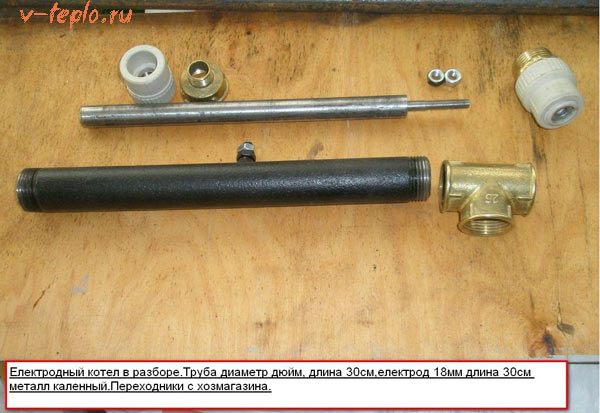

Before you start putting everything together, there are three very important safety rules to remember:
- Only phase is applied to the electrode
- Only the neutral wire is fed to the body
- Reliable grounding must be provided
To assemble the ion electrode boiler, just follow the instructions below:
- First, a pipe with a length of 25-30 cm is prepared, which will act as a body
- The surfaces must be smooth and free of corrosion, the notches from the ends are cleaned
- On the one hand, electrodes are installed by means of a tee
- A tee is also required to organize the outlet and inlet of the coolant.
- On the second side, make a connection to the heating main
- Install an insulating gasket between the electrode and the tee (heat-resistant plastic is suitable)
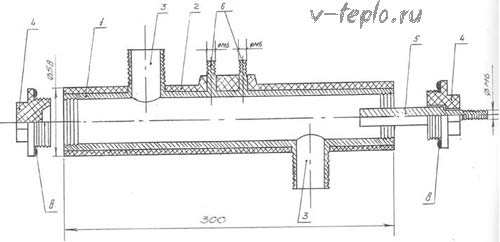

- To achieve tightness, the threaded connections must be precisely matched to each other.
- To fix the zero terminal and grounding, 1-2 bolts are welded to the body
Putting everything together, you can embed the boiler into the heating system. Such home-made equipment is unlikely to be able to heat a private house, but for small utility areas or a garage it will be an ideal solution. You can close the unit with a decorative cover, while trying not to restrict free access to it.
How our sailors live on submarines (17 photos)
The submarine has a rather limited interior space. And all kinds of equipment, fuel, supplies are located there ... How are people accommodated there, who have to spend long days, weeks and months in this closed world. How well thought out is their everyday life?
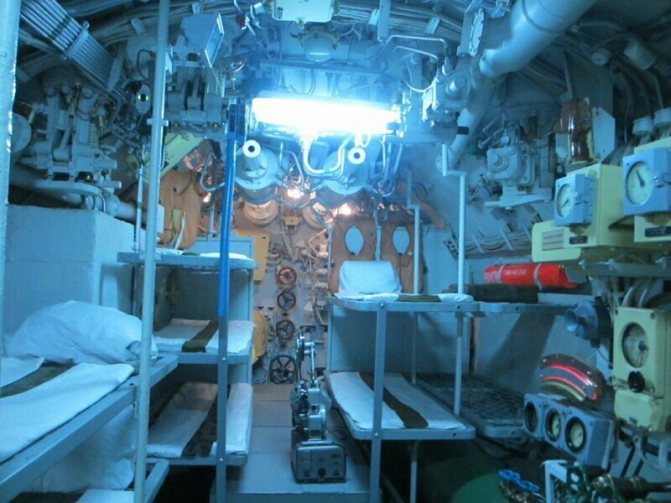

For submariners accustomed to serving on a submarine, it is not unusual to live in a confined space. Nevertheless, any civilian is interested in how the sailors are doing with rest, sleep, water procedures - in a word, everything that any person needs.
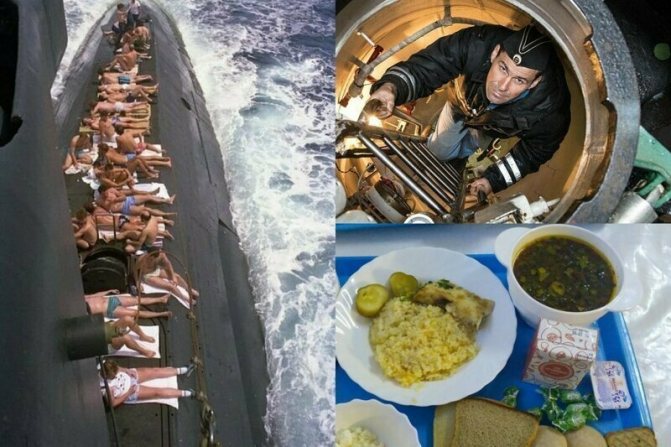

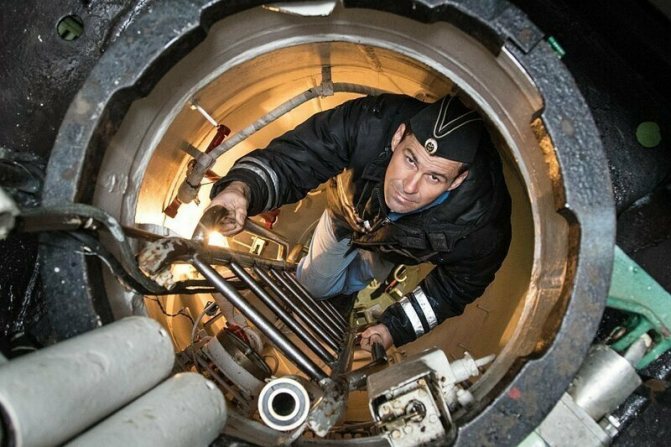

The first thing that is noted by everyone who manages to visit the submarine or see the photos taken there is the tightness. Every centimeter of space is really saved. This photo shows the ladder along which the sailors descend into the submarine. Everything is compact, narrow and comfortable only for slender men. Oversized ones will most likely feel like Winnie the Pooh trying to get out of the Rabbit's hole.
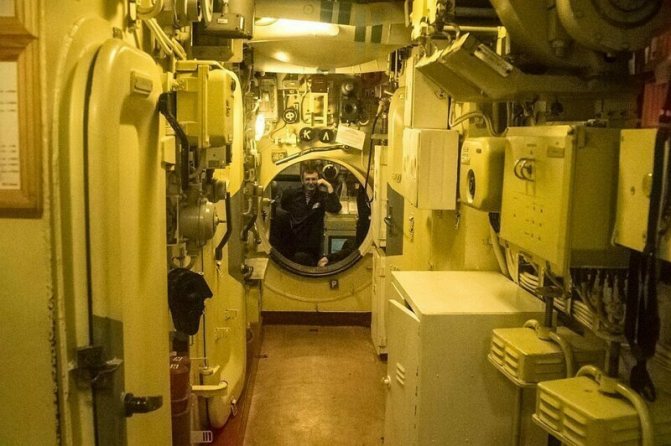

It is just as cramped inside. The corridors are narrow, filled from top to bottom with appliances and equipment. They are also in the galley, and even in the compartments in which the sailors sleep.
Galley
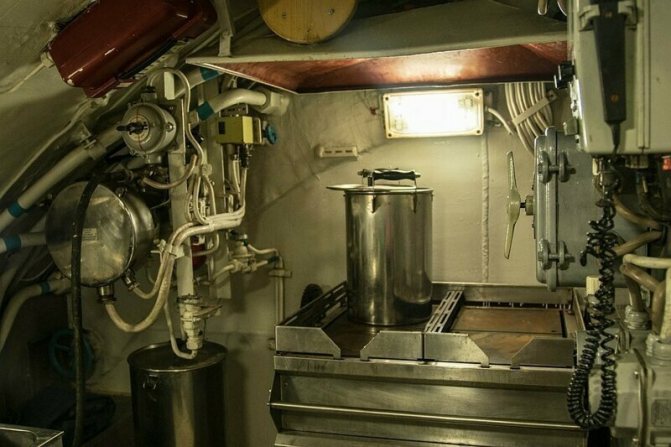

Every centimeter on board is used for several purposes at once.For example, on small submarines, the dining room, if necessary, can act as an operating room, and the torpedo compartment often becomes a gym or a bathhouse. In modern submarines, separate zones have been set up for these purposes.
Officers' mess
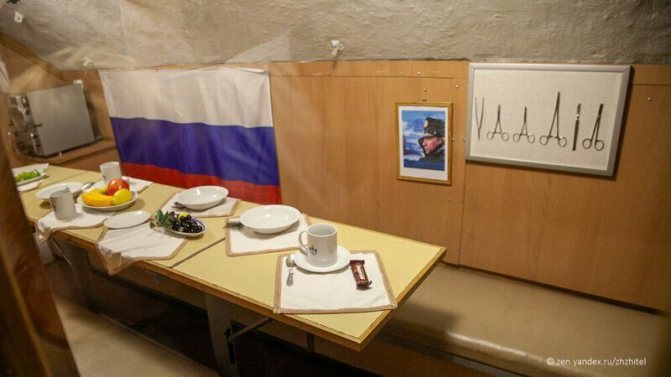

Sleeping places are not only quite narrow and located in the most unexpected places for the uninitiated, but their number does not correspond to the number of employees on the submarine. The thing is that the routine on the submarine is peculiar: the service takes place on shifts, so it never happens that all the sailors sleep at the same time. One sleeps - the other is on duty, and so - around the clock.
Sleeping compartments
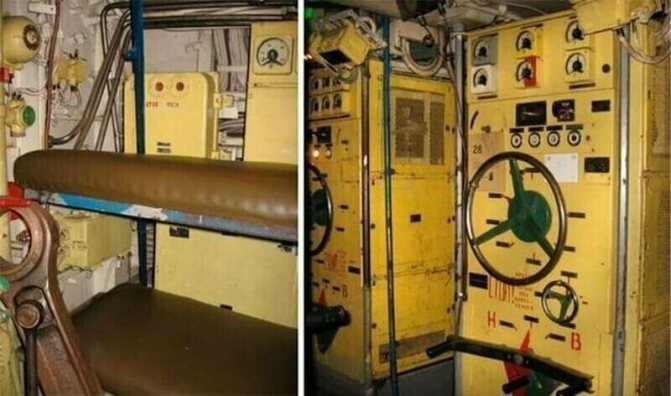

On small submarines, a fold-out meal table may be located in this compartment. Due to space savings, a separate dining room on such submarines is not provided. Sleeping compartments, according to the rules, are not locked, sailors enter and leave there without knocking - a long tradition, so it is simply unrealistic to retire there.
Dining room
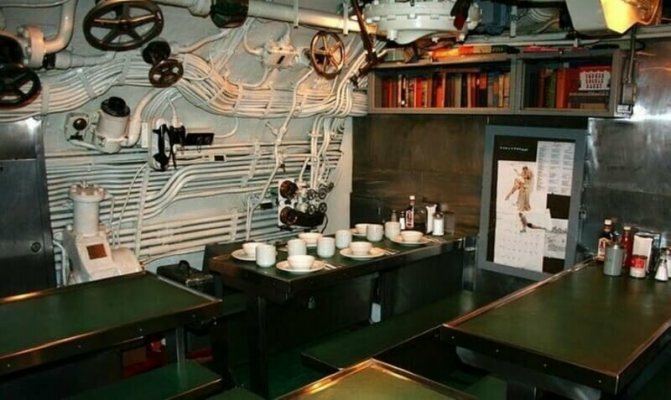

The dining room is where the crew eat and relax. The food on the submarine is excellent - when making up the diet of the submariners, the developers took into account the stressful conditions of service, so they tried to partially and, as far as possible, with good nutrition to compensate for the lack of free space, lack of sunlight and constant voltage. The first, second and third are cooked only once - the food is not stored, therefore it is always fresh.
Galley
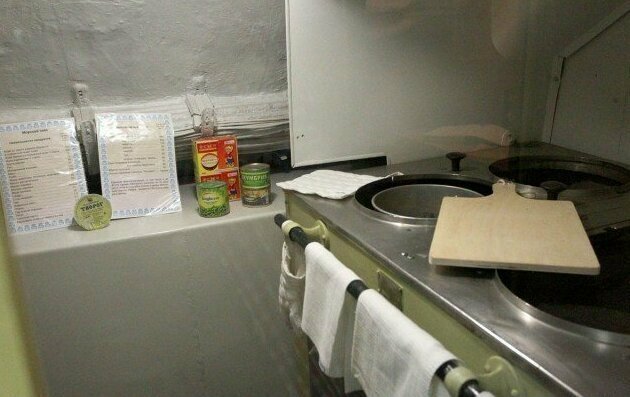

In the first weeks of the hike, perishable food is actively used, so the menu can include the most delicious delicacies: sturgeon, caviar or lightly salted red fish. For example, such a menu for a submarine is not uncommon, but only in the first weeks of sailing: Breakfast: Oatmeal, liver pate, processed cheese, butter, white bread, cookies; coffee, tea, condensed milk, sugar - optional. Lunch: Snack - vinaigrette and sturgeon caviar; for the first - meat broth with vegetables; on the second - pork roast with pasta; dessert - fresh fruit and compote. Dinner: Prepared without first course plus chocolate and 50 grams of wine!
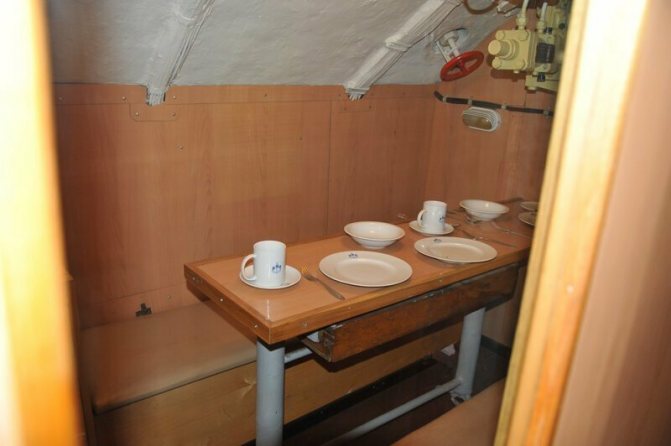

The submarine always stores a supply of food based on the planned days at sea. Distillers are installed on the submarines, so there is no need to worry about drinking water. 50 grams of dry red is a tradition that is maintained on any submarine. Once a day at sea, submariners - whether on a nuclear boat or on a diesel one - are supposed to drink just that amount of wine, no more. Red dry helps maintain important processes in the body of a person who is in conditions of limited movement, and reduces the level of radionucleides and helps not to go crazy from stress.
Traditional food on a submarine


Those who serve on the night shift are entitled to night tea with honey, cookies, condensed milk. A small bar of chocolate and dried fish (sabrefish or roach) are also handed out. Another feature of food on the submarine is alcoholized or frozen (most often) bread, because the sailors could eat fresh loaves and rolls only the first days after the start of the campaign. Previously, bread was not frozen, but impregnated with alcohol. Then the cook put it in an oven, where the alcohol was evaporated and a fresh loaf, like a freshly baked loaf, fell on the table for the submariners.
Rare photo: New Year's menu 1985
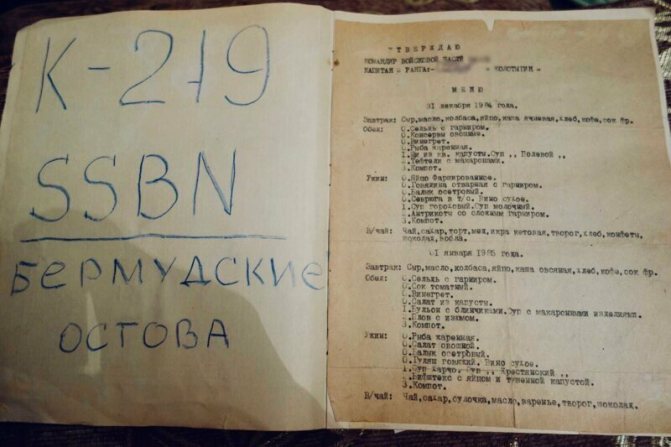

Hygiene
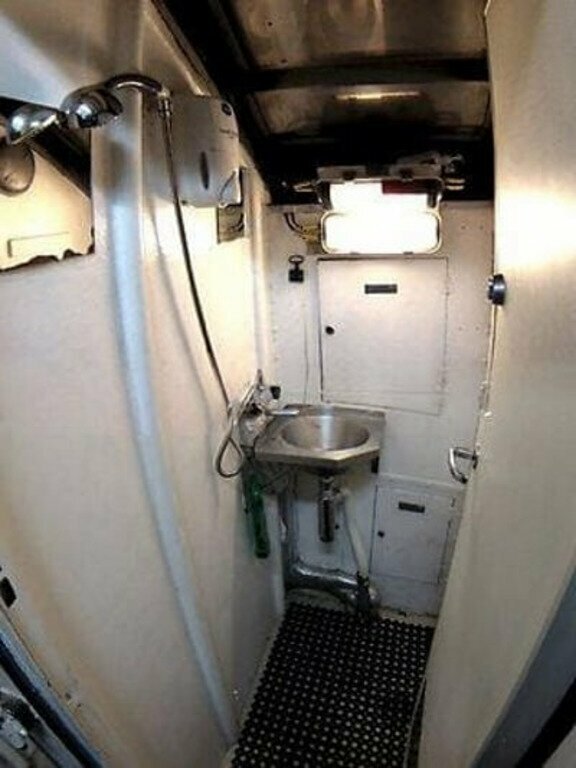

A submarine with a confined space requires certain hygiene rules, otherwise it will be simply impossible to be there. On small submarines, of course, there is nothing but a shower - it is taken quickly, literally in 3-5 minutes. Caring for your comrades. Large modern submarines also have saunas, and even small pools, where sailors plunge after a steam room.
Leisure
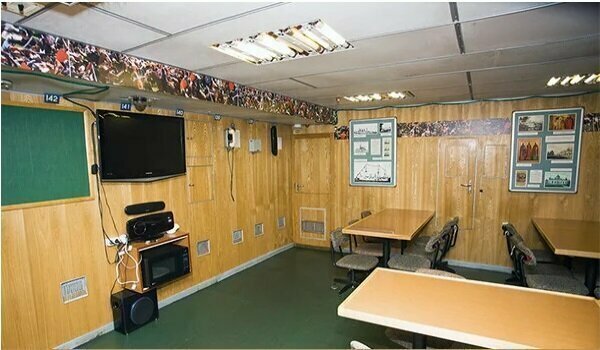

Source: avatars.mds.yandex.net
Large nuclear submarines with a long autonomous navigation have everything so that sailors do not suffer from a lack of comfort: both gyms and lounges. In the latter, they watch movies, play video games, listen to music and celebrate the holidays.
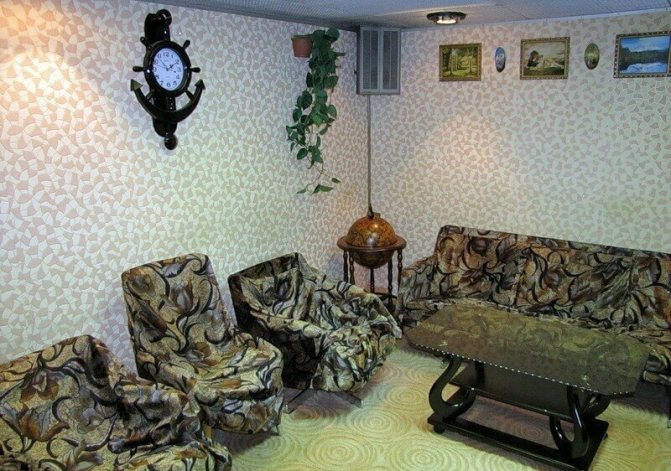

Source: avatars.mds.yandex.net
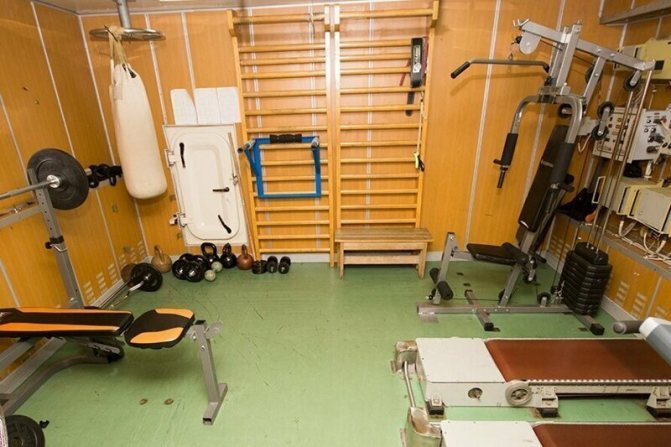

Source: avatars.mds.yandex.net
Of course, small submarines do not have such a simulator due to the lack of space, but almost always there are dumbbells there.
It happens
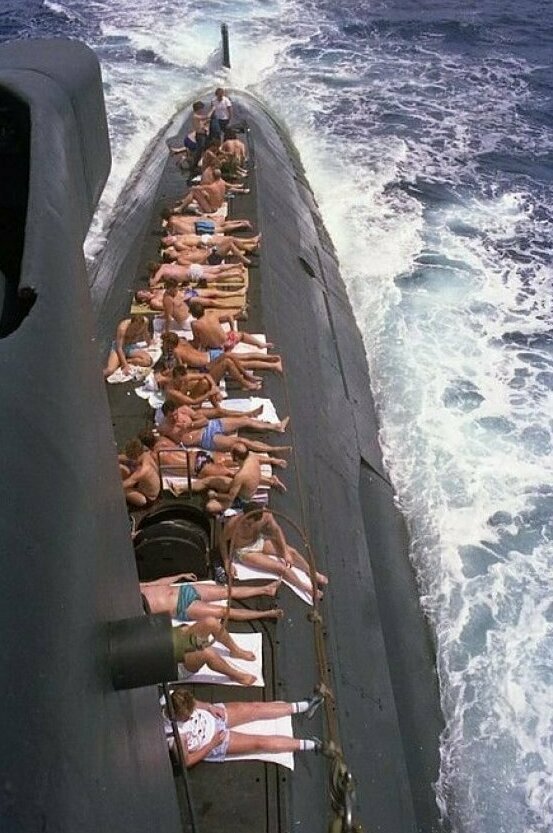

But you can forget about the personal life of submariners during the voyage. Nowhere, once and practically impossible. They either sleep or are on duty. In general, it is better to say about this with a well-known quote: “On a submarine, you can only love one woman - One, and she, like an arrogant wife, creates you all the conditions for you. Even mentally. "
News smi2.ru
Features of installation of ion boilers
A prerequisite for installing ionic heating boilers is the presence of a safety valve, a pressure gauge and an automatic air vent. The equipment must be positioned in a vertical position (horizontal or at an angle is unacceptable). At the same time, about 1.5 m of the supply pipes are not galvanized steel.
The zero terminal is usually located at the bottom of the boiler. A ground wire with a resistance of up to 4 ohms and a cross section of over 4 mm is connected to it. Do not rely solely on RAM - it cannot help with leakage currents. The resistance must also comply with the rules of the PUE.
If the heating system is completely new, there is no need to prepare the pipes - they must be clean inside. When the boiler crashes into an already operating line, it is imperative to flush it with inhibitors. There is a wide range of descaling, scale and descaling products on the markets. However, each manufacturer of electrode boilers indicates those that they consider to be the best for their equipment. Their opinion should be adhered to. Neglecting flushing will fail to establish an accurate ohmic resistance.
It is very important to select heating radiators for the ion boiler. Models with a large internal volume will not work, since more than 10 liters of coolant will be required for 1 kW of power. The boiler will constantly run, wasting part of the electricity in vain. The ideal ratio of the boiler output to the total volume of the heating system is 8 liters per 1 kW.
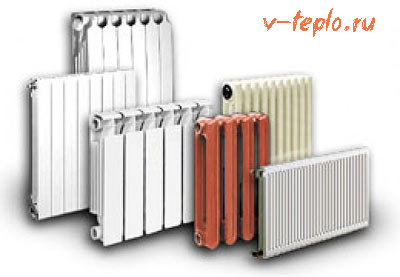

If we talk about materials, it is better to install modern aluminum and bimetallic radiators with minimal inertia. When choosing aluminum models, preference is given to the material of the primary type (not remelted). In comparison with the secondary, it contains less impurities, reducing the ohmic resistance.
Cast iron radiators are least compatible with an ionic boiler, since they are most susceptible to contamination. If there is no way to replace them, experts recommend observing several important conditions:
- The documents must indicate compliance with the European standard
- Mandatory installation of coarse filters and sludge catchers
- Once again, the total volume of the coolant is produced and equipment suitable for power is selected
STRATEGIC UNDERWATER ICEBREAKER
The author of this article, Artem Igorevich Sklyarov, graduated from the FE Dzerzhinsky Leningrad Higher Naval Engineering School, after which he served for three and a half years on the Typhoon submarine. Apparently, he would have continued to serve there now, if the situation in the submarine fleet had not changed so dramatically ...
On the sleeve of the author of the article, A. I. Sklyarov, there is a stripe with the image of a shark introduced specially for the crew of the Typhoon.
On September 23, 1980, NATO announced that the first Soviet Typhoon-class nuclear submarine had been launched at a secret shipyard in Severodvinsk and provided all of its main parameters.
Almost all the premises of the Typhoon, not related to recreation, food and housing areas, are an iron "jungle" of machines and mechanisms, entangled with "vines" of pipelines and cable routes with narrow labyrinths of passages between them.
The main types of submarines in terms of their dominant armament: torpedo, ballistic missiles, cruise missiles.
The world's largest submarine, the Russian submarine Typhoon, is equipped with intercontinental missiles and is intended for operations in the Arctic.
Inside the light steel hull of the Typhoon cruiser, there are two strong cylindrical titanium hulls, interconnected by three passages through intermediate compartments.
Coming to a predetermined square, the Typhoon patrols it for 2 - 3 months at a speed approximately equal to the speed of a quick human step.
‹
›
In the Naval Dictionary, a submarine is defined as: "A ship capable of submerging and operating in a submerged position." Submarines are classified according to various criteria: according to the main armament - into missile, torpedo and missile-torpedo; by the type of the main power plant - into nuclear and diesel (diesel-battery); by design - into single-hull, one-and-a-half-hull and double-hull; by designation - for strategic and multipurpose. Submarines, along with naval aviation, are the backbone of the Russian Navy. And in Russia, in addition to strategic and multipurpose submarines, there is another class of them, which is not found in any other country. These are boats with long-range cruise missiles and a very intelligent autonomous targeting system. Such boats were created in the USSR to confront the aircraft carriers of the US Navy, and now they are inherited by Russia. But our submarine fleet also has a completely unique boat. Its type can be determined using the same classification of the Naval Dictionary: missile, nuclear, double-hull, strategic submarine of the Typhoon class. And its full name, according to the terminology adopted in our Navy, sounds like this: a heavy nuclear-powered strategic submarine.
On September 23, 1980, the first Soviet submarine of this class was launched at the shipyard of the city of Severodvinsk, on the surface of the White Sea. When its hull was still in stocks, on its nose, below the waterline, a drawn grinning shark could be seen, which was wrapped around a trident. And although after the descent, when the boat got into the water, the shark with the trident disappeared under the water and no one else saw it, the people have already dubbed the cruiser "Shark". All subsequent boats of this class continued to be named the same, and a special sleeve patch with a shark image was introduced for their crews. The term "Typhoon", even for those who served on it, remained secret until recently.
This boat was our answer to the Americans, who in April 1979 launched the first of the new class boats, the Ohio. This was followed by Michigan, Florida, Georgia and others; In total, until 1988, 10 such boats were launched - huge submarine cruisers with dimensions: length - 170 m, width - 12.8 m, height - 10.8 m and with a total displacement of 18,700 tons.
But our Typhoon was not just another boat of another new type: it became just one of the components of the grandiose program with the same name - Typhoon. This program was radically different in scale from all previous ones in the USSR and planned an unprecedentedly wide scale of naval development. In the north, along the entire coast of the Barents and White Seas, special berths, workshops, warehouses for storing spare parts and mechanisms were built; roads and railways were laid to them. The so-called "loading points" were built - gigantic structures, nicknamed by the people for some similarity "gallows". Blasting operations were carried out to deepen the fjords in the places where boats were based, created in the rocks a place of possible refuge in the event of a nuclear attack, etc.
The program also provided for an unprecedented routine of service and operation of submarines. In the Moscow region, in the city of Obninsk, a special training center with housing, kindergartens, schools, and hospitals was built under this program.In it, replacing each other, the submariners' crews had to undergo training according to a completely new method.
For each submarine cruiser, it was supposed to have three crews: two combat crews for combat service at sea and one technical crew for troubleshooting, inter-voyage repairs and preparation for a new campaign at the base.
The crews had to work like this. The first combat crew is on alert for two or three months at sea, during which some malfunctions inevitably accumulate on board. Upon arrival at the base, the ship is handed over to the technical crew, and the combat ship - right on the pier, with personal belongings, loaded into comfortable buses and sent to the airport - straight to a specially ordered aircraft. Further - a flight along the route Murmansk - Moscow, after which, taking their families, everyone goes on vacation to different parts of the country.
Meanwhile, the second combat crew, tanned, rested and tired of family comfort, flies with their families from all over the country to the Moscow region, to Obninsk. Here submariners - to refresh their memory and skills - are driven on all simulators, they pass tests and, finally confirming their high combat effectiveness, fly with their belongings on the return special flight Moscow - Murmansk. Then the crew travels by return special bus directly to the pier - to the ladder of their cruiser, already fully prepared for a new military campaign. The boat is taken from the technical crew, the ladder is removed, and the ship goes into combat service, controlled by the second combat crew. In the same way, the whole process is repeated over and over.
Everything described is already related to the operation of the boat. But it also had to be built, which required colossal production capacity. The assembly line alone at the Severodvinsk Machine Building Plant in Severodvinsk stretches along the coast for many kilometers. But this is just an assembly. Component parts were manufactured at factories throughout the country. One can only try (although it will hardly be possible) to imagine how the whole program was conceived as a whole. Perhaps it was one of the most ambitious national programs in the USSR.
Not all of the plans were implemented: there was not enough money, time, and the relevance of strategic submarines with nuclear weapons has become somewhat different.
Submariners do not fly on a special flight Murmansk - Moscow: they live permanently in a military town, a few kilometers from the base. In the mornings, to get to the ship, the so-called "kungi" - huge buses based on KAMAZ trucks - are stormed. Sometimes the loading is personally supervised by high authorities. Those who could not break into the kung stomp straight across the hills. In summer, and even in good weather, it is a pleasure, but in winter, in a blizzard, you cannot reach the service, and it happens that the service is automatically canceled.
The construction of structures also stopped long ago. What has already been built continues to amaze the American observers who often visit those parts, and ours are also surprised. Both the scale and the incomprehensibility of the purpose are striking. Even for specialists, tunnels cut through granite hills, beautiful roads leading simply "nowhere" remain a mystery: the road rests on the edge of the coast - that's all! Magnificent berths, with supplied communications, titanic structures of unknown purpose - all this is not completed, has never been exploited. Probably, now no one knows exactly what was actually conceived, what the Typhoon program was in its entirety. And it is absolutely certain that this program will never be completed.
Of the entire program, perhaps only the boat itself was created in full. Our story will be about her. And it is possible to name, it is even necessary to name the chief designer of the submarine cruiser - Igor Dmitrievich Spassky.
This submarine, by design, could not be ordinary. She had to become "the very-very".This was demanded by creative pride, and at least what she did in defiance of the eternal probable enemy - the Americans - with their Ohio class boats. And in many ways we managed to do it.
The displacement of the Typhoon submarine when fully submerged is 27,000 tons, the length is 170 m, and the width is 25 m. KAMAZ can be deployed on the Typhoon deck. The height from the keel to the top of the deckhouse fence is 25 m, which corresponds to a seven-story building, and, by the way, with high ceilings. And when the sliding devices are raised, a nine-story house is already obtained.
In some ways, but in its dimensions, the Typhoon is comparable, perhaps, not with boats, but with surface ships, and moreover with the largest ones. For example, the largest US nuclear-powered aircraft carrier, the Nimitz, has a standard displacement of 81,600 tons. Our largest (and currently the only) aircraft carrier "Admiral Kuznetsov" - 65,000 tons. It is easy to see that our submarine Typhoon is only three times smaller than their largest surface aircraft carrier.
The main armament on the Typhoon is 20 RSM-52 ICBMs with 10 nuclear warheads each. The rocket weighs almost 100 tons, has a length of 16 and a diameter of 2.5 m.
As you know, on August 6, 1945, 71,000 people died in Hiroshima, 68,000 people were wounded, 60% of the city was destroyed. Meanwhile, the power of that first American bomb was only 20 kilotons, which is equivalent to one nuclear warhead. One can imagine what destructive potential is concentrated on one such boat - these are 200 cities like Hiroshima. And as a defensive weapon, there are six torpedo tubes and several dozen torpedoes and torpedo missiles on board.
For comparison, Ohio has 24 Trident missiles with 14 warheads each, and this could destroy 336 cities. That is, in the most important thing - in weapons - "Typhoon" failed to become "the most-most". Why did it happen? But because with dimensions comparable to our rocket (length 13.4 m and diameter 2.1 m), the Trident weighs almost 2 times less - 59 tons.
Until recently, strategic boats with ballistic missiles were surrounded by a certain aura of mystery and romanticism, and in general, their stealth is considered the main tactical property of submarines. This is doubly true for submarine missile carriers who patrol in an unknown square, in the endless expanses and depths of the oceans, from where missiles can be suddenly launched. The entire enemy fleet and especially its hunting boats are looking for, tracking down submarine missile carriers, hunting them. And their hunting boats defend them. Hunters have chases, detachments, evasions, but all this romance is not for a missile carrier. It crawls slowly and stealthily at the quietest speed, about 5 knots (this is equivalent to a fast human walking). And so for 2-3 months - far from romance, monotonous and hard work, with daily familiar surprises. Even the daily practice of fake missile launching does not add much variety.
The submarine Typhoon differs in that it was created specifically for sailing in the Arctic - under the ice. Its main power plant is designed to operate in the cold waters of the Arctic, and if the temperature of the surrounding water rises above +10 degrees, then this can already create quite serious problems for mechanics. Therefore, the Typhoon has been ordered to travel to the warm southern oceans. He cannot go somewhere to the Atlantic, especially to the warm Mediterranean Sea. However, it makes no sense for him to go somewhere far to the southern latitudes, because there is no place for him in the World Ocean safer and more comfortable than under his native Arctic ice.
The average depth of the Arctic Ocean is 1225 m, the maximum is 5527 m, but a significant part of its bottom is continental shoals, where the depths are relatively shallow.Typhoon is designed specifically for these depths of several hundred meters, and in almost any area of the cold ocean there is such a secluded place for it to lie on the ground and hide.
The movement of the missile carrier is provided by two pressurized nuclear reactors with a capacity of 360 MW each. This energy would be quite enough to illuminate the hero city of Murmansk with its few suburbs. On a boat, this power is spent on the rotation of two steam turbines, which rotate two six-blade propellers with a diameter of three human height.
The outer contours of the boat resemble a flattened loaf of bread, but this is only the shape of the outer thin and light hull. Its purpose is to reduce resistance when driving underwater. Inside it is a solid case with machines, mechanisms and people living among them. This inner, robust Typhoon case is unique and has never been done before. It consists of two parallel cigar-shaped cylinders with a diameter of 10 meters each with three passages through the intermediate compartments: in the bow, in the center and in the stern. Thus, it turns out that two boats are located in one common light hull. They are usually referred to as "port side" and "starboard", meaning the entire left and right cylindrical cigar. In these solid sides, everything is duplicated: reactors, turbines, all mechanisms and even cabins, so there are only two in the missile carrier. And if everything fails in one half, then the other will allow you to fully complete the combat mission and return to the base. To distinguish the right and left sides, it is customary to number everything on the left with even numbers, and everything on the right with odd numbers. By the way, all the specialists in the team also have exactly one pair, and they are called specialists of the right and left boards.
Between the light outer and strong inner hulls, there is a rather large space where immersion tanks, all sorts of containers and in general everything that can not be protected from high pressure and the action of sea water are located. And containers with missiles are also located near the Typhoon in this space: between the sides - in front of the boat, in front of the wheelhouse. By the way, this is the only rocket boat in which the missiles are located in front of the wheelhouse. Other boats, as it were, "drag" the missiles behind them, and the Typhoon "pushes" its missiles ahead of itself.
When submerging, the entire space between the sides is filled with seawater, and the boat accelerates and drags all this mass of water along with it. Water constitutes the total moving mass, which determines the boat's inertia, and therefore its maneuverability.
The main external enemy of submarines is noise. He unmasks the boat, which is generally a matter of life and death for a missile submarine. It turned out that in the Typhoon, the interaction between a simple, lightweight and complex, durable hulls allowed for an unprecedentedly low noise level. The Typhoon also got another - quite unexpected - result. They say that once, somewhere in the Spitsbergen area, a female blue whale mistook our cruiser for a male whale and circled around for several hours, apparently trying to mate with him. She emitted a roar that turned into a whistle, and the acoustics even managed to record this love serenade on magnetic tape. They also say that killer whales sometimes rub against the hull of the ship and crackle and whistle at the same time, like birds, over the entire ocean. For whom they take the cruiser is not completely clear, but clearly for someone of their own. And in any case, it is obvious that the noise characteristics of the Typhoon do not scare away marine life, but even vice versa. A very interesting achievement, although hardly planned in advance.
The main weapons are those developed at the NPO. VP Makeev intercontinental ballistic missiles - located in vertical shafts between two strong sides (cylinders) in the bow of the ship.Like an umbilical cord, these missiles are connected by communications with equipment in the compartments of a strong hull, which, by the way, is not completely symmetrical. The equipment on one side serves to test missiles, and the other to prepare and conduct launches.
Each of these 100-ton missiles is capable of hitting a target at a distance of up to 9000 km, which means that you can get to the equator from the North Pole. And even before America, this was enough and even more so - therefore, the submarines had the opportunity not to go far from their northern bases. It is both convenient and safe. But if we continue to compare our "Typhoon" with the American "Ohio", then the firing range of the Trident missiles is even greater - about 12,000 km. Such a range provided the possibility of shelling any point on the territory of the USSR from the Indian Ocean, the safest for the United States.
On the Typhoon, the crew is provided not only with good, but inconceivably good living conditions for submarines. This, perhaps, one would expect from the Nautilus, but not from a real boat. For its unprecedented comfort, the Typhoon was nicknamed the "floating hotel" - partly out of envy, partly with a degree of disdain. When designing the Typhoon, apparently, they did not particularly strive to save weight and dimensions, and the team here is housed in plastic sheathed wood-like 2-, 4- and 6-berth cabins, with desks, bookshelves, lockers for clothes. sinks and TVs. There is also a special recreation complex on the Typhoon: a gym with a Swedish wall, a crossbar, a punching bag, bicycle and rowing machines, and treadmills. (True, some of this - in a purely Soviet way - did not work from the very beginning.) There are also four showers on it, as well as as many as nine latrines, which is also very significant.
A sauna lined with oak planks, generally speaking, is designed for five people, but if you try, you can place ten in it. As the temperature rises, the oak begins to emit a completely unique aroma, which is very useful for the lungs. And there is also a small pool on the boat: 4 meters long, 2 meters wide, and 2 meters deep. The pool can be filled with either fresh or salty seawater - cold or warm. There is also a solarium on the Typhoon, where you can take an ultraviolet bath, but for some reason the tan turns out with a greenish tinge.
In a cozy and quiet lounge, where there are rocking chairs and singing canaries, fish and indoor flowers, you can turn one of its walls into a landscape - by choice: forest, mountains, steppe, Crimean beach and much more - only about three dozen options. And apart from this hall there is also a room with slot machines for amateurs.
There are two wardrooms operating on the Typhoon: one for officers, the other for warrant officers and sailors. As you know, the mess-company is called on the ship "a room serving for collective recreation, classes, meetings and a common table." Four meals a day were taken on board. The menu is the most exquisite under the Soviet system and quite tolerable under the conditions of modern fleet financing. Standard breakfast, lunch and dinner must contain something meaty. And once a day, a small glass of dry wine is put in, only 50 grams - not for drunkenness, but to combat vitamin deficiency. The so-called evening tea ("so-called" - because under the water the usual days seem to disappear) with condensed milk, honey, cookies, bagels are also accepted. Ship chefs (coca) are especially renowned for their skill and invention. Former Typhoon officer AA Kulakov told how in one of the Moscow restaurants he was treated to a unique and very expensive seaweed salad prepared by a famous Chinese chef. But it was not possible to surprise the officer with this salad, since he had tasted the same before, when he served on a submarine. He even looked into the kitchen to see if the cook was cooking them there? But no: it really was a real Chinese.
And ship chefs are in no way inferior to restaurant ones, and the dishes prepared by them are usually eaten clean. Moreover, uneaten food, like all food waste in general, is a very serious problem on a submarine.
There are no garbage bins on the submarine, it is impossible to store rotting waste, and if any aggressive smell spreads through the compartments of the submarine, then it is almost impossible to weather it. Therefore, food waste and any other garbage on the boat are packed in special plastic bags and once every three days they are "shot" overboard from a special apparatus DUK (to remove containers). At depth, by the way, it is not at all easy to do it - it is much more difficult than in space. There, when the hatch of the transition chamber is opened, the cosmic vacuum sucks everything out by itself, but under water, on the contrary, it is necessary to "push through" the external water pressure. And the "shot" bags with waste then sink to the bottom, where their contents are gradually eaten by sea inhabitants.
Everything else, not included in the fabulous list of cabins, recreation areas and dining rooms, is an iron "jungle" of machines and mechanisms, entangled with "vines" of pipelines and cable routes with narrow labyrinths of passages between them. These "jungles" are ungrateful to describe and are interesting, perhaps, only for specialists.
The air on board is controlled very carefully, fixing and adjusting more than ten parameters. It is constantly being cleaned from harmful impurities and carbon dioxide, for which whole systems of filters and absorbers are used. Oxygen is produced by two special installations that split fresh water into hydrogen and oxygen by means of electrolysis. (The fresh water itself is partly taken with them, and partly "boiled" with the help of "special" desalination plants.) Hydrogen is removed overboard, and oxygen is injected into the atmosphere of the compartments and stirred by ventilation. Its quantity is maintained at the same level - 21%. They very thoroughly clean the air on the Typhoon from dust: there is no such clean air on earth. But it is still impossible to compare it with natural: no artificial tricks can replace real natural air and sunlight. And to sailors slightly green after a long stay under water, the real living air seems fabulously fragrant and sweet.
It is easy for a person who gets on a boat for the first time without a guide to get lost. Once observers from the Academy of Sciences of the USSR went to sea on the Typhoon, and one of them decided to walk the cruiser alone. The ship was already leaving the pier, on board, as always at this time, there was a turmoil, and the annoying explorer was getting in the way. Pushed by curiosity, he continued to squeeze through compartment after compartment, no one was interested in him and did not bother him. And suddenly the deck under his feet disappeared, and, flying about 4 meters down, he crashed into empty cardboard boxes. As soon as he could make out the frozen pork carcasses swinging on hooks, he saw a hatch above him slammed shut. It became dark, quiet and cold. He shouted, knocked on the iron with his bare hands - no results. In order not to stiffen, he began to squat. Squatted and squatted - never squatted so much in my life. In the meantime, the hour of supper was approaching, and the cocas came down for meat. They opened the provisioning chamber, and out of the icy darkness, a strangely smiling man ran briskly to meet them, mumbling incoherently and gesticulating with numb hands. The rumor of the incident instantly spread throughout the ship. The sailors received a scolding for not closing the loading hatch on time, and in general everyone got it. And the rescued person, by the way, was very lucky this time, because usually the freezer is opened no more than once every two days. And it’s just an accident that at that moment there were cutlets on the menu, but for the first laying of meat there was not at hand. Therefore, he spent only two hours in one tracksuit at a temperature of minus 10 degrees.It turned out, by the way, that other observers did not even notice the disappearance of a colleague, and indeed no one on board noticed such a "trifle". And after this incident, everyone arriving aboard the Typhoon - observers, inspectors, journalists, etc. - even on the pier, they strictly instruct that you should move around the boat at least in pairs. It is also recommended to immediately remember the main life route: cabin - galley - latrine. And from this route - nowhere, and if something is needed, then only with an accompanying person.
Usually the boat leaves on a mission on a campaign secretly, deep at night, so as not to see the vigilant enemy. True, "deep night" in the polar summer is a relative concept, but nothing can be done about it - it's a tradition. All the commanders go out to see the boat, but by no means relatives: this is a bad omen. Seeing off is strict, stingy, short. Returning from a hike is quite another matter. The boat usually returns during the day (although imagine a "day" in a polar winter). And this is a common holiday. Of course, all the command goes out to meet the boat, but the most important thing for the submariners is the families, who are also all, in full force, with children gather at the "spine" of the pier. Friends and acquaintances come, the whole town flocks. Further, on the pier itself, civilians are not yet allowed. A heavy cruiser moors slowly, for a long time, it takes three to four hours. Even on a “hot” polar day it is rather cold, very windy, but everyone is patiently waiting.
Finally, the cruiser was moored. The entire team (except for those on duty) line up on the pier. The division commander congratulates the crew on the successful arrival and fulfillment of the combat mission. Orders, medals and shoulder straps are solemnly awarded - usually, it is to this day that awards and titles are accumulated. The wives of the officers and warrant officers prepare a rather large package with sweets, cookies and other tasty things and hand them over to the conscripts. There are very few of them on the cruiser, but there is practically no one to meet them, the poor, in the town. The whole team is also given a roasted piglet - this is also a sacred custom. After that, families and friends are allowed to chat with the crew, but very briefly: hug, talk, communicate the most urgent things, taste a little something light, most often champagne. And half an hour later, the crew returns to the board again and sits there for about six hours: this is necessary to take the reactor out of operation and begin to cool it down. The entire crew, of course, must be in full readiness, because this process is a very responsible one.
In winter, they also go hiking at night. Walking in the dark on the surface, the Typhoon is a rather eerie sight: a black, slowly and soundlessly creeping mountain with a single pulsating light (pulsar) on the wheelhouse.
First, the cruiser has to overcome a long curving fjord with numerous islands. The bays and fjords of the Kola Peninsula, and not only it, generally constitute an increased danger for navigation. And especially for the Typhoon, because its draft is more than 12 meters. When you have to enter the repair base in the shallow White Sea, they blow through all the tanks and get out of the water as much as possible: even the edges of the screws are shown above the water. They crawl very slowly, accompanied by a pair of tugs, and from time to time back up, feeling for a narrow and shallow fairway for the Typhoon. By the way, for such maneuvers on the cruiser there are two more small screws: one in the bow, the other in the stern - they extend from the bottom and can turn 360 degrees.
Previously, the fjords were literally crammed with light and radio beacons, ground crossings and other landmarks. Now almost half of these funds are in need of repair or replacement. We must take off our hats in front of the commanders, navigators and officers of the watch, who manage to escort such a giant in narrow skerries. And this is done by the methods of the Pomors, in the old fashioned way, by eye.By word of mouth, they convey visual cues that are understandable only to the initiated. The legend of the wiring sounds like this: as soon as the first stone appears from behind that rock, take 5 degrees to the right, and when the second appears - another 3 degrees to the right, etc. This information is not included in any official document. It can rightfully be attributed to oral folk art.
Out into the open sea, where the depth is already sufficient, the boat dives. It will not pop up again for a long three months, unless it is necessary to do it on purpose. For all this time, the boat must disappear, dissolve. She will not give any signals, no messages on the radio - just listen. And only then, after returning from the campaign, it suddenly emerges in approximately the same place where it dived. The romance of secrecy is what characterizes her.
So, the cruiser went to the dive point. Final preparations before diving. Everything is checked very carefully, up to the fact that people on board are counted over their heads: God forbid forgetting someone above. And only then the upper conning tower hatch is battened down and the dive begins. For this there is a whole system of so-called main ballast tanks. When the cruiser is on the surface, they are "blown" (filled with air) and the ship floats on the surface. When the tanks are completely filled with water, the boat is able to hang freely in the water - at any depth. To submerge, the tanks are filled one by one. The ship is slightly sunk, then nasal horizontal rudders are extended, which are usually hidden in a light hull. The last tanks are filled with water and at the same time the bow and stern rudders are shifted for immersion. The cruiser, leaning slightly forward, smoothly disappears from the water surface. This entire process usually takes a Typhoon no more than 20 minutes.
There are, however, situations when an urgent need to disappear from the surface, there are only two of them: either a ship or an enemy aircraft. And then the whole process of immersion takes a few moments. Designed for such emergencies, the rapid immersion tank is almost instantly filled with water through two large openings. The cruiser immediately loses its buoyancy and goes down like a stone. This process proceeds like an avalanche: the upper conning tower hatch has not yet been closed, and the deck is already leaving from under our feet. The commander dives into the hatch last, and he battens him down, sometimes getting the last few buckets of icy water on his head. But as soon as the whole ship disappeared under water, it must be immediately "caught" - to stop its fall down. To do this, water is urgently squeezed out of the dangerous tank through a special valve using air at a pressure of 400 atmospheres. If you are late with this, then the cruiser can fall to a dangerous depth.
By the way, the following depths are distinguished for submarines: periscope (very small, at which the sea surface can be observed through a periscope); limiting (at which the body is not damaged yet); 20% less than the limit - working (which guarantees long-term normal operation of all systems and devices); design (1.5 and more times more than the limit). So, the boat should not fall deeper than the maximum depth, otherwise it can plunge even deeper, where it either hits the ground with its acceleration, or it will be crushed by water pressure.
Diving to great depths is generally dangerous. Nobody knows exactly where the calculated depth is, because when the maximum depth is reached, the ship already begins to feel it. Its robust, very thick steel body begins to crackle from the resilient compression. Shrinking itself, it squeezes the cabins, and if the doors of the cabins were open before submersion, then it is no longer possible to close them at depth, and if they are closed, then no forces can open them. After surfacing, everything returns to normal.
The last person who sees the surface of the sea when diving is the commander looking through the periscope.(According to the instructions, he must stand at the periscope both when diving and when surfacing). A funny incident happened in the early 90s somewhere in neutral waters. For some reason, the Typhoon had to surface. There was complete calm and heavy fog. The crew crawled upstairs scattered across the slippery deck, fixing some minor malfunctions without undue haste. Everything was quiet and calm, and suddenly the silhouette of the Norwegian reconnaissance plane "Orion" - the old foe of all our submarines in the Barents Sea - floats out of the milky fog straight ahead. This "pterodactyl" flies over the deckhouse itself, and from it, like fleas, orange buoys - special small marine microphones - are pouring down. They float on the surface, listen under and around the water and transmit to the center data on the presence of Russian submarines. Everything happened so unexpectedly and quickly that the team remained standing with their mouths open, surrounded by NATO floats. When the roar of the plane began to grow again, the commander roared from the bridge: “Everyone down! Urgent immersion !!! ". The people from the deck were blown away like the wind: with a roar and shouts, they one after another dived into the hatch, fell on each other's shoulders. The deck, meanwhile, had already gone down. The commander glanced around the bridge ("It looks like everything!"), Also dived down and closed the hatch. In the central post, combat commands were already distributed, interspersed with impressions: someone forgot their gloves at the top, someone lost their cap, someone left their tools. The commander habitually stuck his forehead into the window of the periscope and suddenly ... instead of the horizon running upward, he saw the skewed face of the boatswain. A few seconds later the cruiser flew to the surface, and after a few more seconds a wet boatswain rolled into the central post. With almost complete Russian folklore, he expressed his dissatisfaction with those present. Behind him rolled down the commander, who already with complete Russian folklore expressed his dissatisfaction with the boatswain, and his mother, and everyone present, and Norwegians, etc., etc. The boatswain was given a glass of alcohol - to restore health and a severe reprimand - just in case. It remained a mystery, including for the boatswain himself, how he could not hear the roar of the commander, and also how he, having 130 kg of live weight (!), Managed to climb up the wheelhouse and even jump to grab the rising periscope. This emergency immediately flew around the entire Kola Peninsula. And it gave rise to a dozen additional instructions for the registration of personnel on surface and submarines.
(The ending follows.)
Nuclear submarine "Kikimora Kalugin", project P-95K
Home »Alternative shipbuilding - Fleets which did not exist» Nuclear submarine "Kikimora Kalugin", project P-95K
Alternative shipbuilding - Fleets which did not exist Alternative shipbuilding - Which fleets did not exist
jonnsilver 07/11/2016 351
0
Favorite Favorite Favorite 0
A page on my site - https://skb-86.awardspace.biz/kikimorakalugina.htm (there are pictures in higher resolution)
I drew the first Kikimora for the Horror of the Depths contest alone in total secrecy (so that no one would steal the idea), so it turned out exactly as I intended. After the end of the competition and the publication of the project, the participant of the Paralay forum ikalugin proposed to make a revised version, which by the name of the initiator became known as Kikimora Kalugin.
If the competitive Kikimora focused on multi-purpose capabilities (a separate missile compartment in addition to torpedo armament) and various creative solutions (like a 605-mm TA), then Kikimora Kalugin's emphasis was on anti-submarine warfare, reinforced torpedo armament of 533-mm caliber with an additional complex of active protection. Also, a number of improvements were made to hydroacoustic and radio-technical weapons.
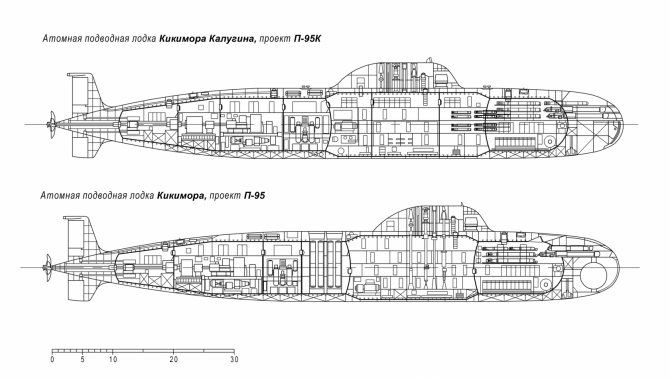

Nuclear submarine Kikimora for the "Terror of the Deep" competition
Technical solutions
For the prospective promising nuclear submarine of the Russian fleet, the following technical solutions were adopted:
- Based on the competitive Kikimora
The hull is taken from the P-95 project while maintaining the overall architecture and basic dimensions. The differences lie in the layout solutions (which are discussed below) and in a different set of weapons. The power plant is practically the same as on the P-95. The differences are in the higher power of the turbine generator (4000 kW) and the low-speed electric motor (2000 kW or 2700 hp), which increases the low-noise running speed to 9 knots. - Targeting anti-submarine warfare
The goal was the ability to resist the American Virginia-class nuclear submarine and the British Astute-class. Weapon concept changed. It was decided to abandon the compartment with UVP for anti-ship and cruise missiles. Return to the standard caliber of ammunition - 533-mm, the number of torpedo tubes increased to 8 pieces, and 533-mm ammunition to 30 units. At the same time, due to the increase in the power of torpedo armament, the possibilities for the use of missiles are not lost. The boat is equipped with the Caliber complex. - Active anti-torpedo protection
To counteract enemy anti-submarine ammunition, the ship received 8 onboard 324-mm torpedo tubes - launchers. The torpedo tubes are located in the middle of the hull, leaving the breeches in the second compartment. There is also ammunition in the second compartment. The missiles and anti-torpedoes of the "Packet" complex are used as ammunition. - The latest electronic weapons
The boat is equipped with a large aperture quasi-conformal HAS (instead of a "ball"). A similar layout is implemented on the project 677 submarine. Also, the boat has two onboard low-frequency conformal antennas and is equipped with retractable devices that do not penetrate into the strong hull. - High equipment reliability and good habitability
Due to the low power requirements, the power plant has a greater specific weight in comparison with boats of previous projects, which makes it possible to increase the reliability of the equipment. Those. the crew's efforts to maintain the equipment in working order will be significantly less and the boat will have a higher utilization rate than on older projects. The high level of habitability is ensured by the large area of residential and utility premises. All personnel are located in three five-tiered compartments (2, 3 and 4). At the same time, combat posts are located on the upper tiers, and residential and utility rooms on the lower ones. This allows you to create a rational layout of the living quarters, taking into account the ergonomic requirements, to reduce the level of noise and vibrations, to equip the boat with an effective heating, ventilation and air conditioning system.
Performance characteristics and design
The boat has a one and a half hull architecture. The body consists of 8 compartments. The hull in the area of the 2,3 and 4 compartments has a single-hull design and a robust hull diameter of 10.5 meters, and in the rest - a double-hull. The diameter of the robust case of 1, 5 and 6 cylindrical compartments is 8.6 meters. Robust 7 and 8-compartment housing - frusto-conical. The material of both the light and durable body is high-strength steel.
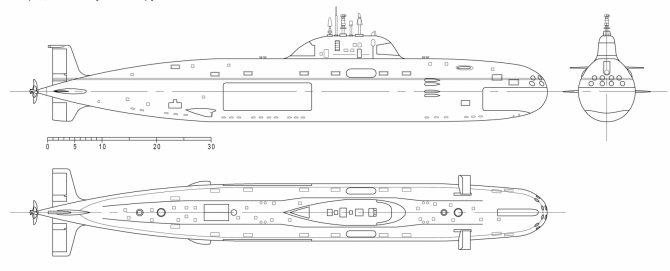

Tactical and technical characteristics
| Name | Indicator |
| Displacement | surface - 6,000 tons underwater - 7,000 tons buoyancy margin - 16.7% |
| Dimensions (edit) | length - 95.0 m width - 16.0 m (hull - 10.5 m) draft - 8.0 m |
| Speed | surface - 12 knots of low noise - 9 knots of full speed - 25 knots |
| Immersion depth | working - 400 m limit - 550 m |
| Autonomy | 100 days |
Boat compartments
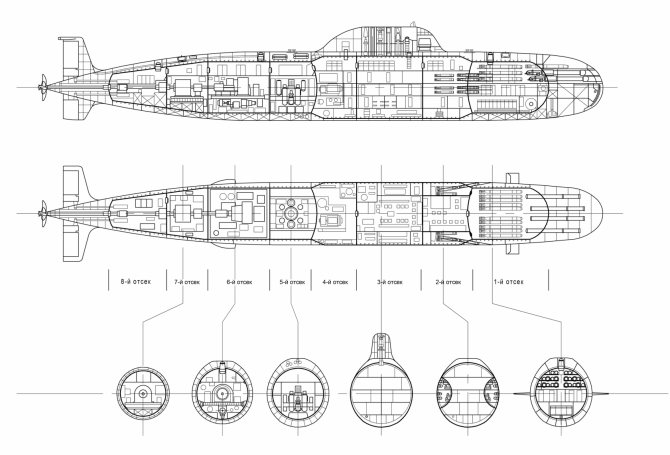

First compartment
- torpedo, in its upper half there are breeches of torpedo tubes and all 533-mm ammunition (30 units) on automated racks. Under it is a room with racks for electronic weapons equipment, ventilation and air conditioning of the compartment. Below them are the holds and the battery pit.
Second compartment
- torpedo-technical. Along the sides of the compartment there are 8 324-mm TA, 4 from each side, in strong enclosures designed for the full immersion depth.Also in the compartment are combat positions for controlling torpedo firing.
Third compartment
- management. On the upper deck there is a central post and a BIUS enclosure. On the 2nd, 3rd and 4th decks - living and medical premises. 5th deck - hold.
Fourth compartment
- auxiliary mechanisms. Decks 1 and 2 - conning houses and power-generating unit REV diesel generator, compressors and refrigeration unit. In the same compartment there is a kaboz and pantries for storing food.
Fifth compartment
- reactor. The reactor itself with its equipment is isolated from the rest of the boat by biological shielding. The PPU itself, together with the systems, is suspended on cantilever beams embedded in the bulkheads.
Sixth compartment
- turbine. a turbine generator (under the platform) and a full-speed turbine (under the platform) are located on one damped platform, and separate condensers for the turbine and the turbine generator are also located there. The unit stands on the intermediate frame through shock absorbers, which is fixed to the bulkheads through the second shock absorber cascade.
Seventh compartment
- a rowing electric motor. on a special cushioned platform, a reversible low-speed trolling electric motor with a clutch to turn off the GTZA.
Eighth compartment
- tiller. A shaft line with a main thrust bearing in the bow and a propeller shaft seal in the stern passes through it. The compartment is double-deck. It also houses the tiller compartment, which houses the steering hydraulic machines, as well as the tiller and rudder stock ends.
Above the second, third and fourth compartments there is a fencing for the cabin and retractable devices. In the stern - four stabilizers form the stern plumage. The main entrance to the submarine is through the deckhouse fence. In addition, there are auxiliary and maintenance hatches above the first, fifth and seventh compartments.
Crew - 60 people, including 35 officers and 25 warrant officers, senior officers are accommodated in single cabins, officers in double cabins, warrant officers in four-bed cabins. Living quarters are located in the second and third compartments, the galley and ventilation systems in the fourth compartment. The average living space is 3.1 m2 per person.
Power plant
The power plant of the submarine is atomic. Implemented in three compartments - reactor, turbine and propeller motor. The main difference from the boats of previous projects is the minimization of the power capacity with a simultaneous increase in the specific weight, which improves reliability and at the same time minimizes the number of units (one at a time), but increases the reliability of their operation.
Includes:
- nuclear reactor - thermal power 70 MW, with two steam generators, one primary circuit pump on each. The reactor can operate in a low-noise mode with natural circulation at a power of 20% of the nominal, providing steam only to the boat's turbine generator.
- full speed turbine with planetary gear. Shaft power - 20,000 hp The maximum speed is 25 knots.
- turbine generator - 4000 kW
- low-noise low-speed low-noise electric motor with an output of 2000 kW (2700 hp)
One diesel generator with an electric power of 1500 kW and a storage battery located in the first compartment are used as an emergency source of energy.
The main propeller is a seven-bladed low-noise propeller with a diameter of 4.5 meters. Auxiliary - two retractable dispensers with a capacity of 420 hp, providing a speed of up to 5 knots. It was decided to abandon the installation of water cannons due to lower efficiency and lower efficiency at low speeds.
Armament
The Kikimora Kalugin weapons complex includes:
- eight 533 mm torpedo tubes. Ammunition, located on automated racks - 30 units. UGST torpedoes, mines of various types and missiles of the "Caliber" complex can be used as ammunition: anti-ship missiles - 3M-54, anti-submarine missile torpedoes 91R1 and cruise missiles - 3M-14.
- eight 324-mm torpedo launchers, 24 ammunition.As ammunition, 324-mm small-sized thermal torpedoes - MTT and anti-torpedoes - ATE complex "Package" are used.
- 6 PU MANPADS "Igla"
Hydroacoustic complex
- one nasal active-passive mid-frequency quasi-conformal antenna GUS
- two onboard conformal passive mid-frequency antennas GUS
- two high-frequency GAS self-defense complex
- passive low-frequency towed GUS
- navigation and anti-mine high-frequency GAS
Retractable devices and communication antennas
- universal optronic periscope - in addition to several optical channels, it is equipped with a laser rangefinder and a thermal imager;
- multipurpose digital communications complex - provides both terrestrial and space communications in several ranges;
- radar / electronic warfare complex - is a multifunctional radar with a phased antenna array capable of detecting both surface and air targets, with the additional ability to jam;
- RDP - a device for operating a diesel engine under water;
- digital complex of passive electronic intelligence - instead of old radio direction finders. It has a wider range of applications and, at the same time, due to the passive mode of operation, it is not detected by the enemy's RTR.
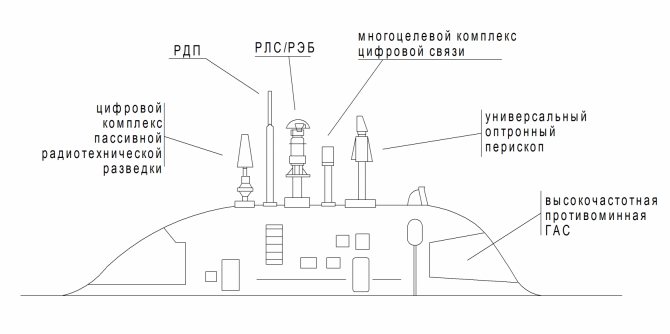

Comparison with competitors
In connection with the anti-submarine orientation, it is relevant to oppose modern enemy boats. In this matter, Kikimora Kalugin surpasses the boats of Project 971.
The boat has three main advantages over its competitors:
- high stealth and adequate driving characteristics;
- advanced detection tools;
- powerful weapons, including a missile system and active anti-torpedo protection.
When confronted with NATO anti-submarine ships, the P-95K project boat penetrates any single ship or anti-ship missiles or torpedoes.
| Ship | Kikimora Kalugin | USS Vermont | HMS Artful | Cheetah |
| type / project | P-95K | Virginia-class | Astute-class | project 971 |
| Displacement above water | 6000/7000 | 7300/7800 | 7000/7400 | 8140/12270 |
| Number of weapons | 8 х 533 mm TA, 8 х 324 mm TA, 30 533 mm torpedoes, 24 324 mm torpedoes | UVP for 12 Tomahawk missiles, 4 533-mm torpedo tubes, 26 torpedoes | 6 533 mm TA, 38 units of torpedo and missile armament | 4 533 mm TA, 4 650 mm TA, 6 external TA / PU, 28 533 mm torpedoes, 16 650 mm torpedoes, 6 simulator torpedoes |
| Power point | 1 nuclear reactor 70 MW, 1 turbine with a capacity of 20,000 hp 1 rowing motor | 1 reactor S9G2 steam turbines with a total capacity of 40,000 hp speed over 25 knots | 1 Rolls-Royce PWR 2 reactor | 1 reactor OK-650M.01 (190 MW), 1 turbine with a capacity of 50,000 hp |
| Hydroacoustic weapons | GAC: GAS with quasi-conformal GAS in the bow, conformal airborne GAS, high-frequency GAS self-defense and passive BUGAS | AN / BQQ-10 Sonar Suite: Large Aperture Bow (LAB) sonar array, wide aperture lightweight fiber optic sonar array, two high frequency active sonars mounted in the sail and bow, Low-Cost Conformal Array (LCCA) high frequency sonar | Thales Sonar 2076: Type 2079 active-passive bow sonar, Type 2078 fire control bow element, Type 2065 towed array, Flank array | SJSC MGK-540 "Skat-3": bow antenna, two onboard vertically developed antennas, flexible extended towed antenna |
